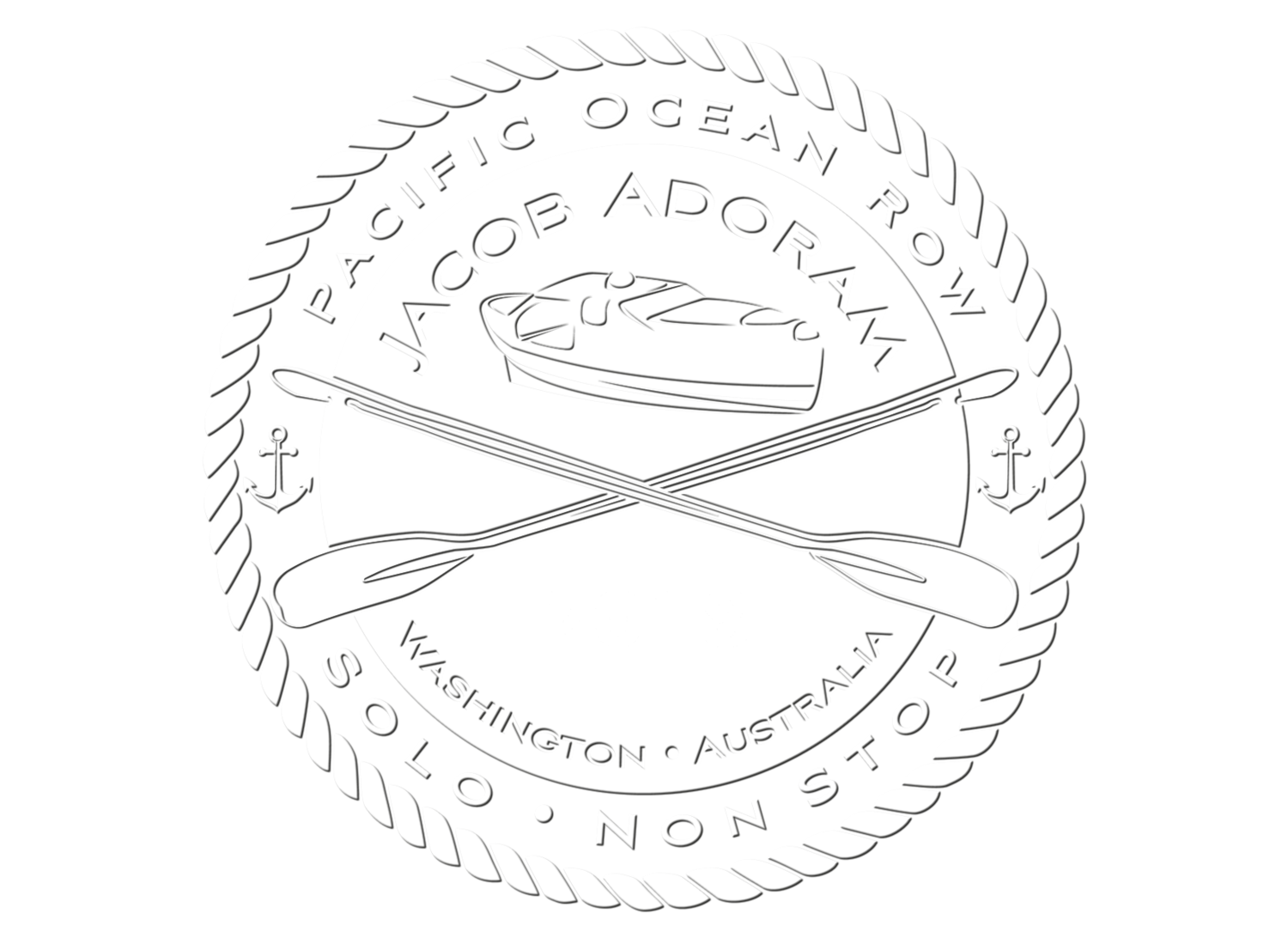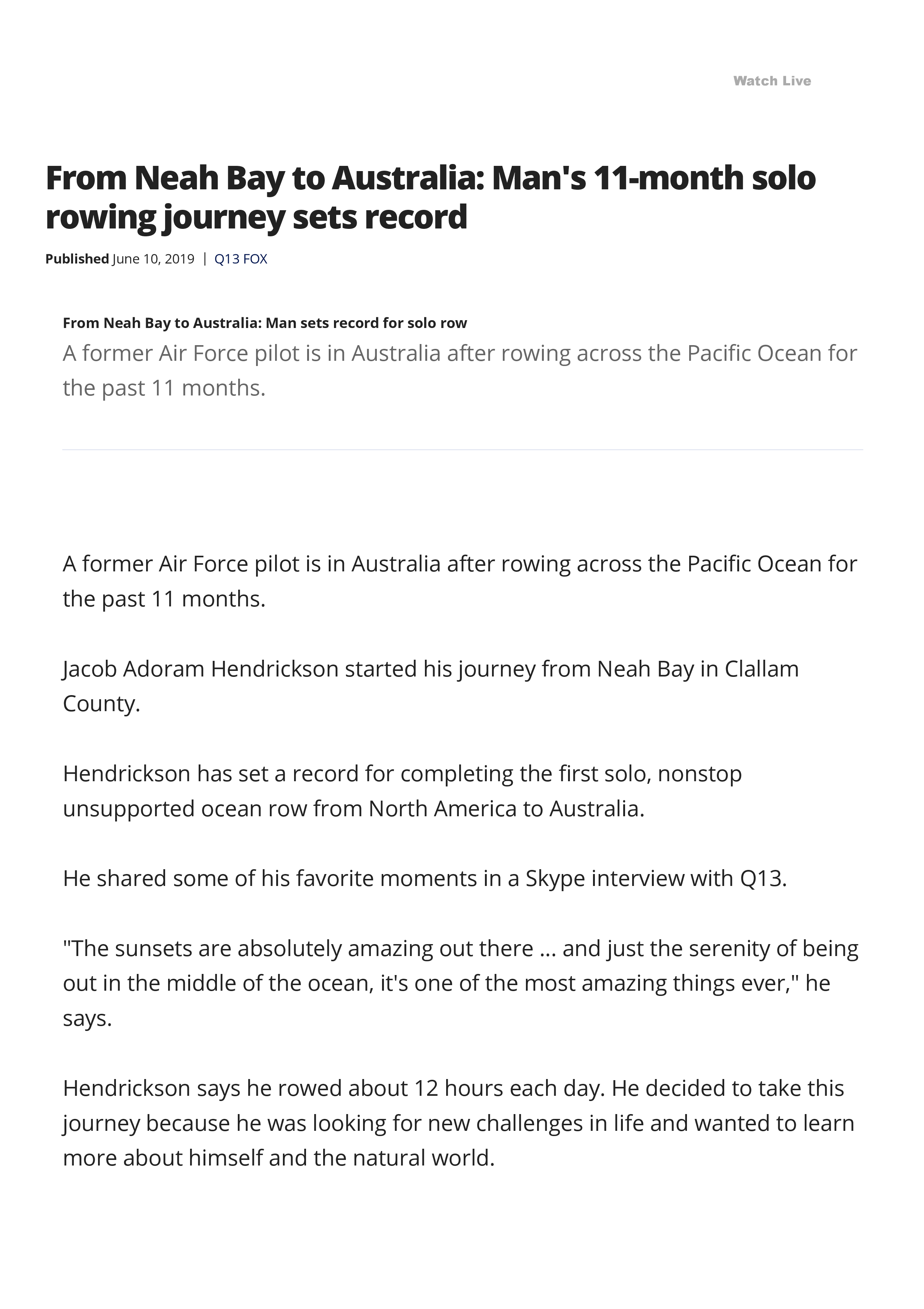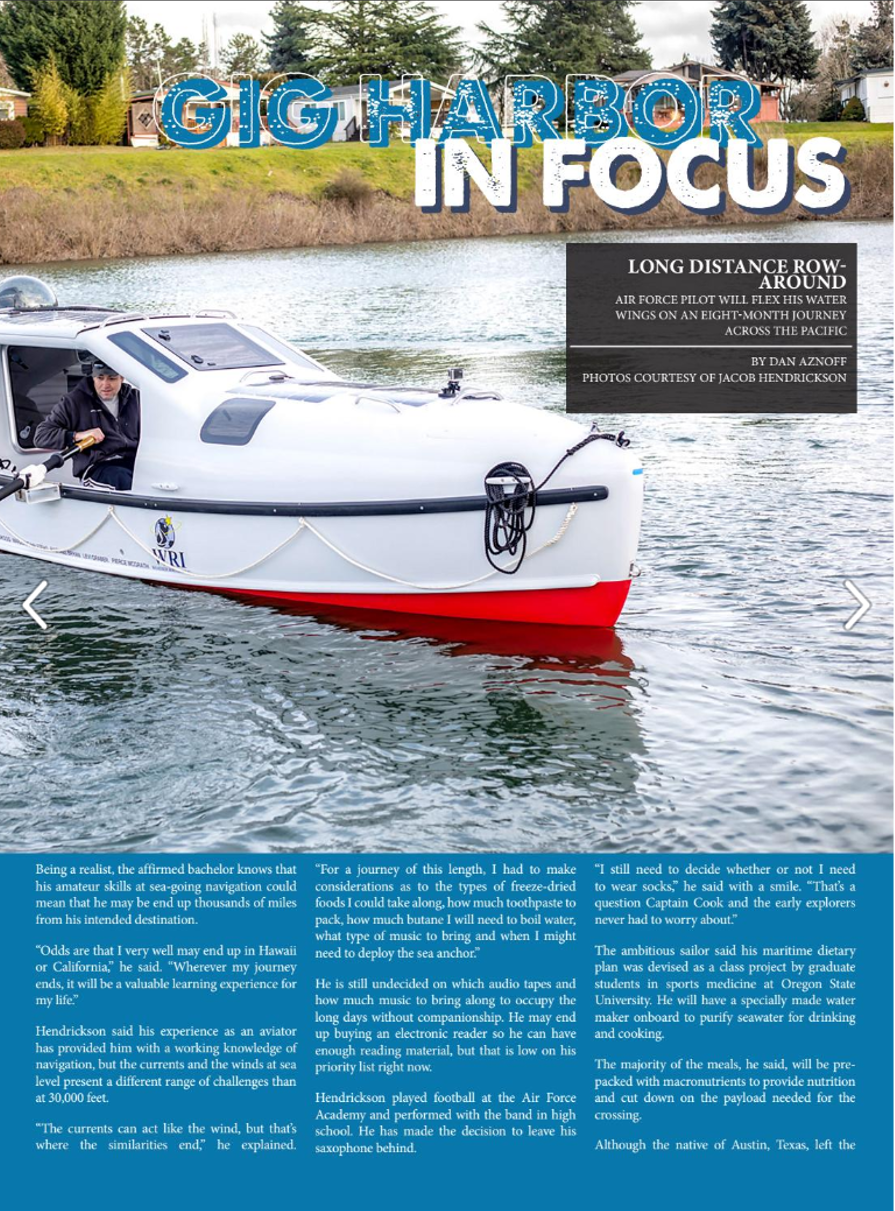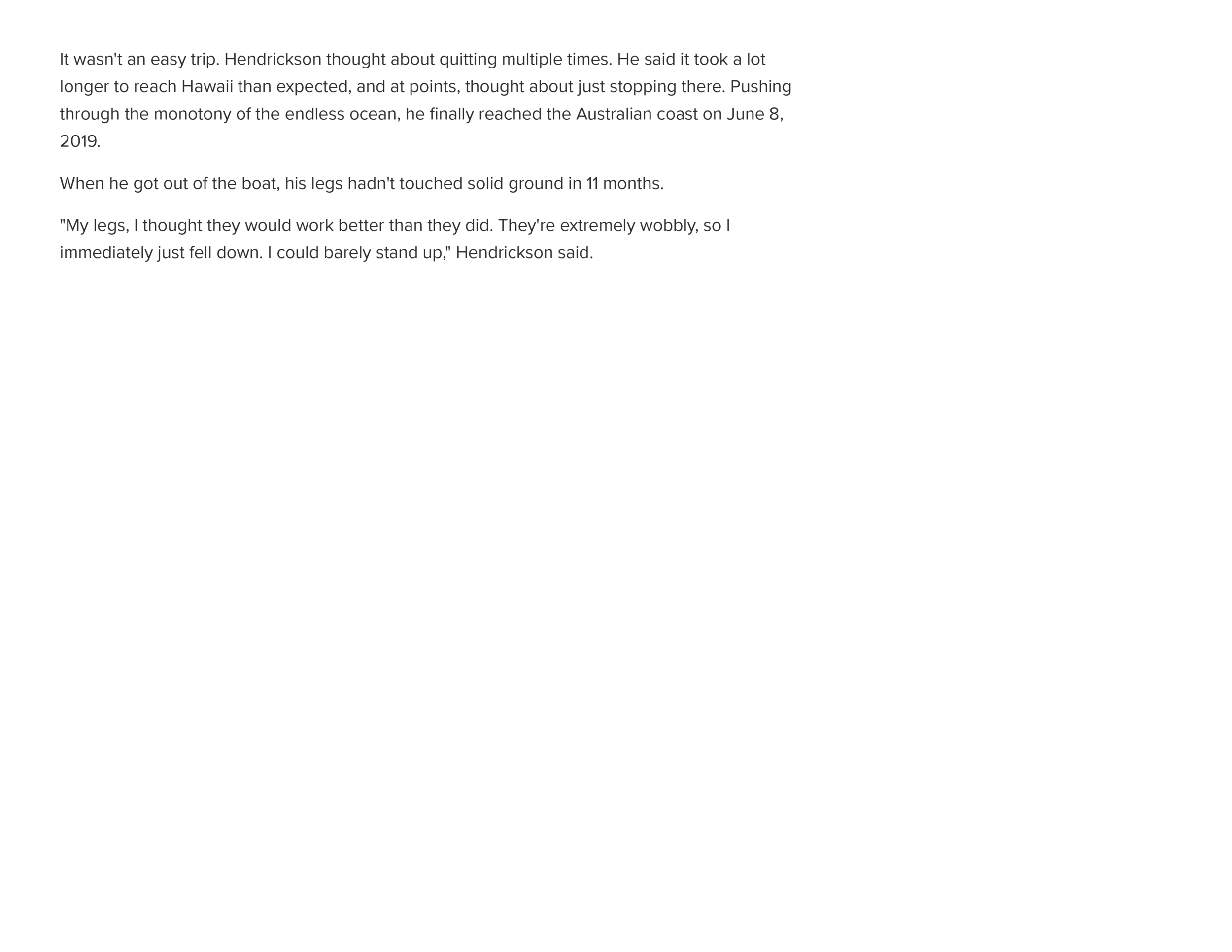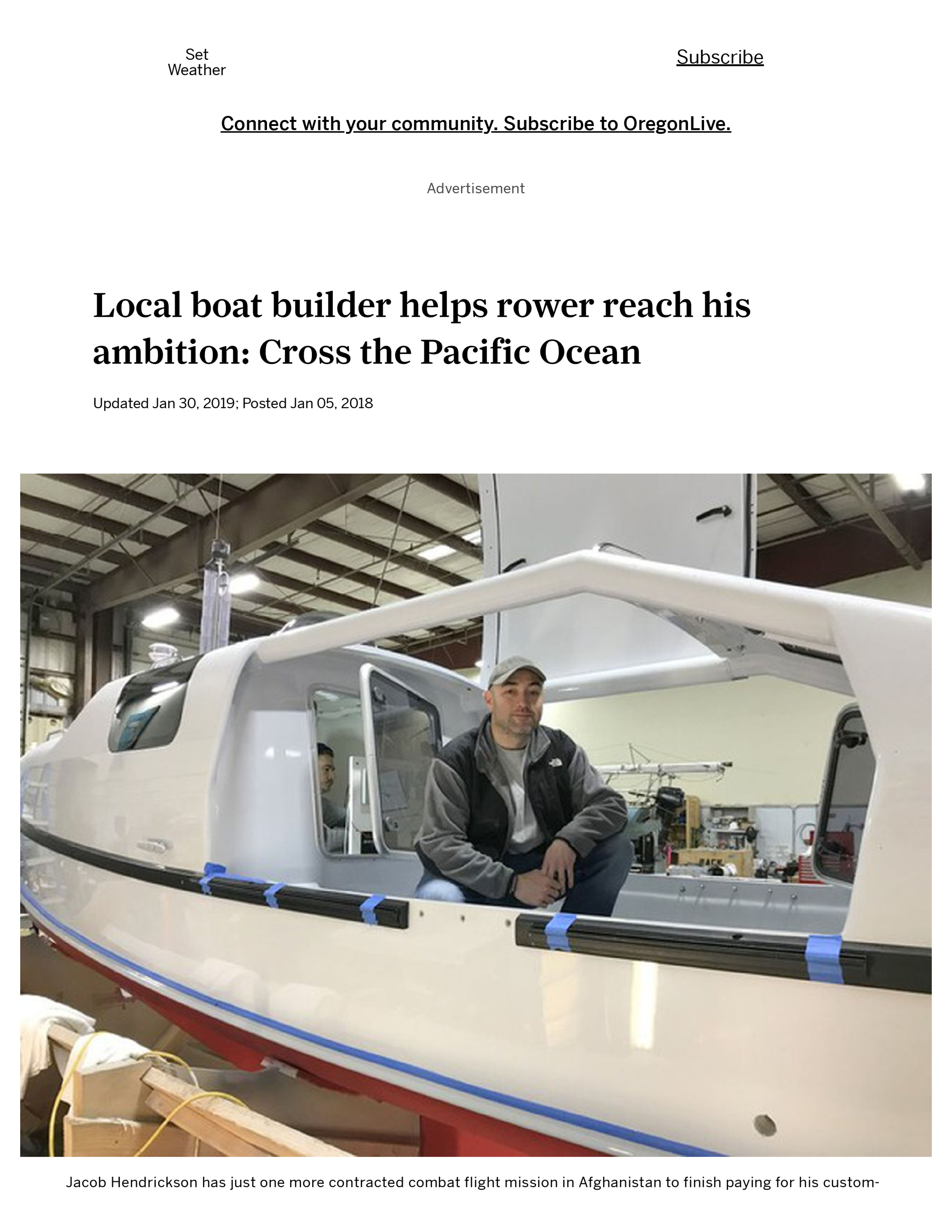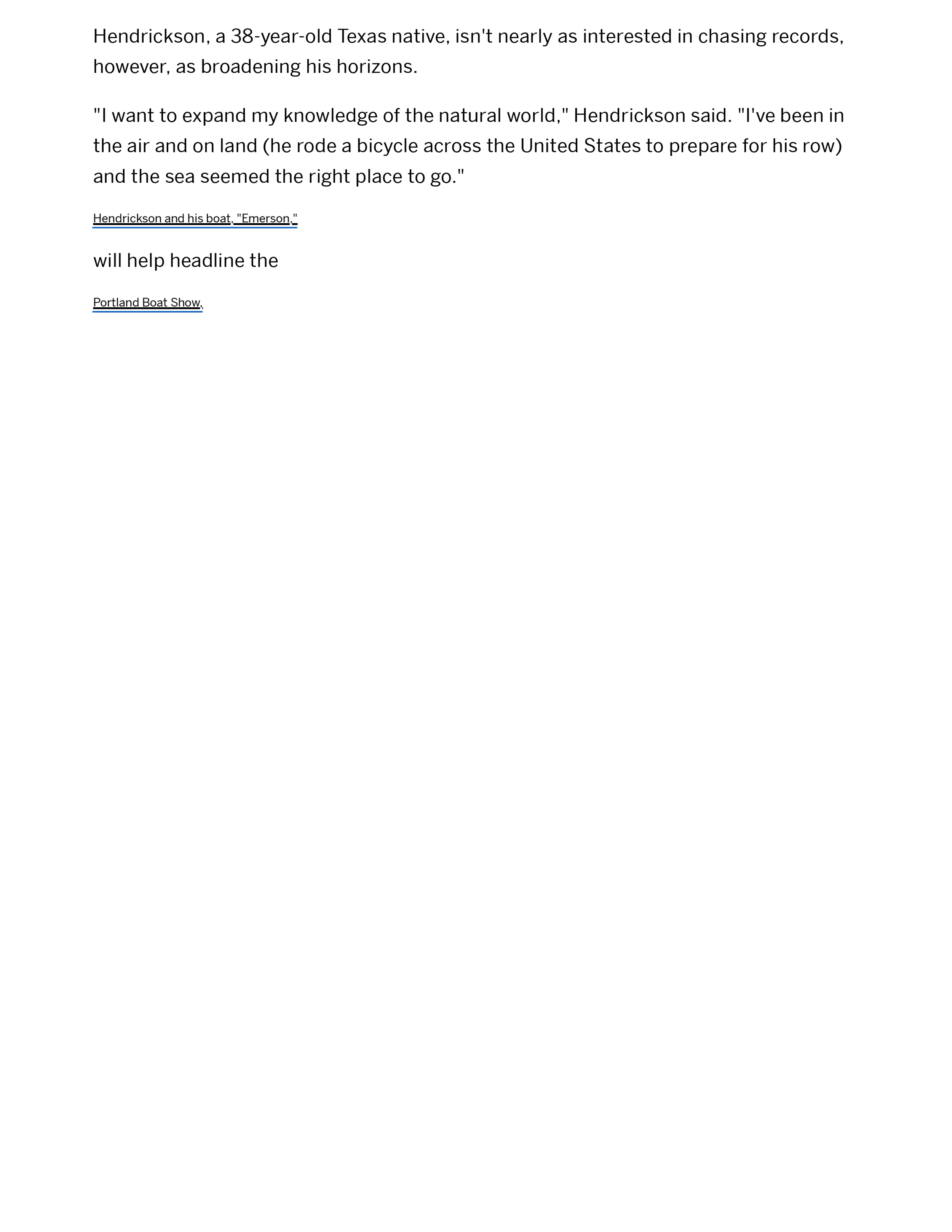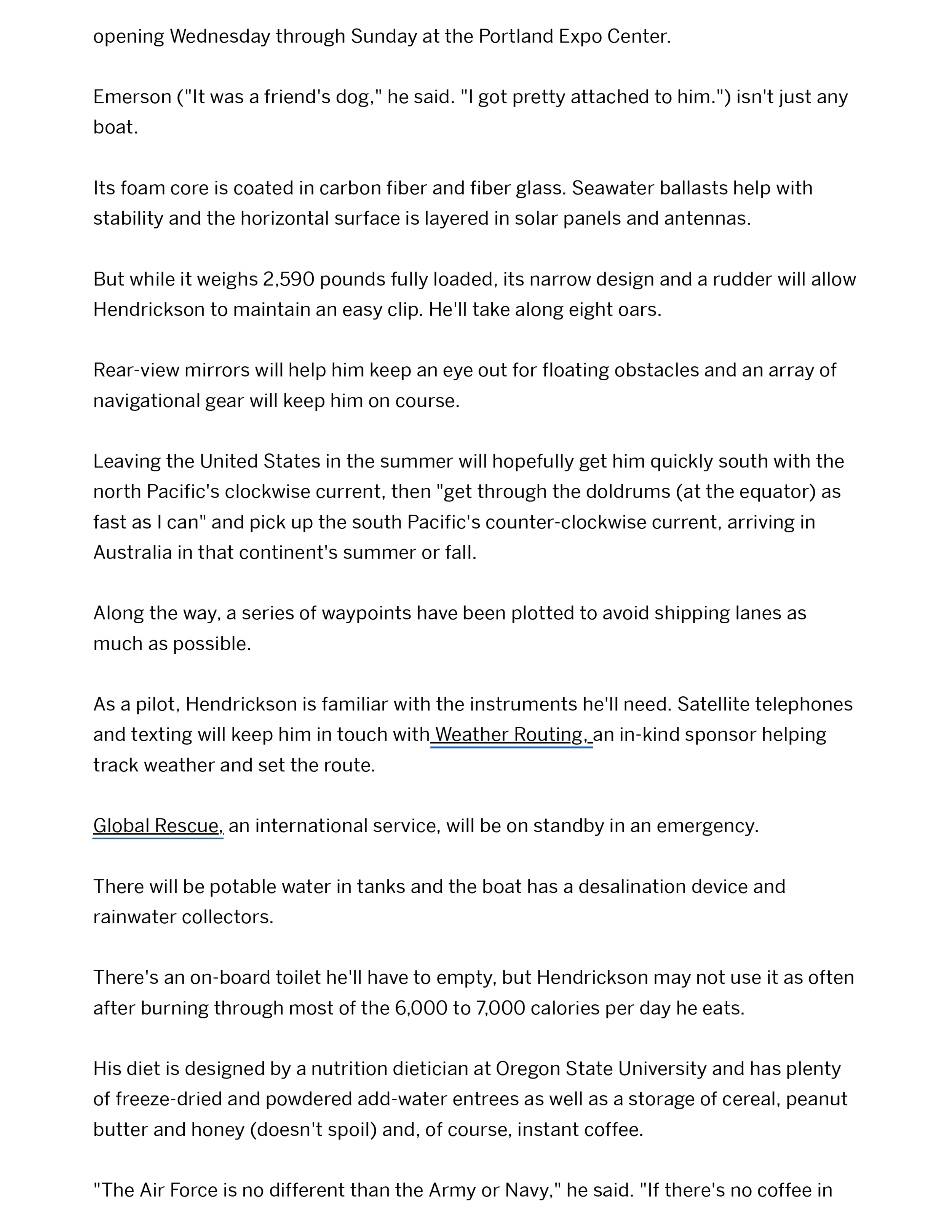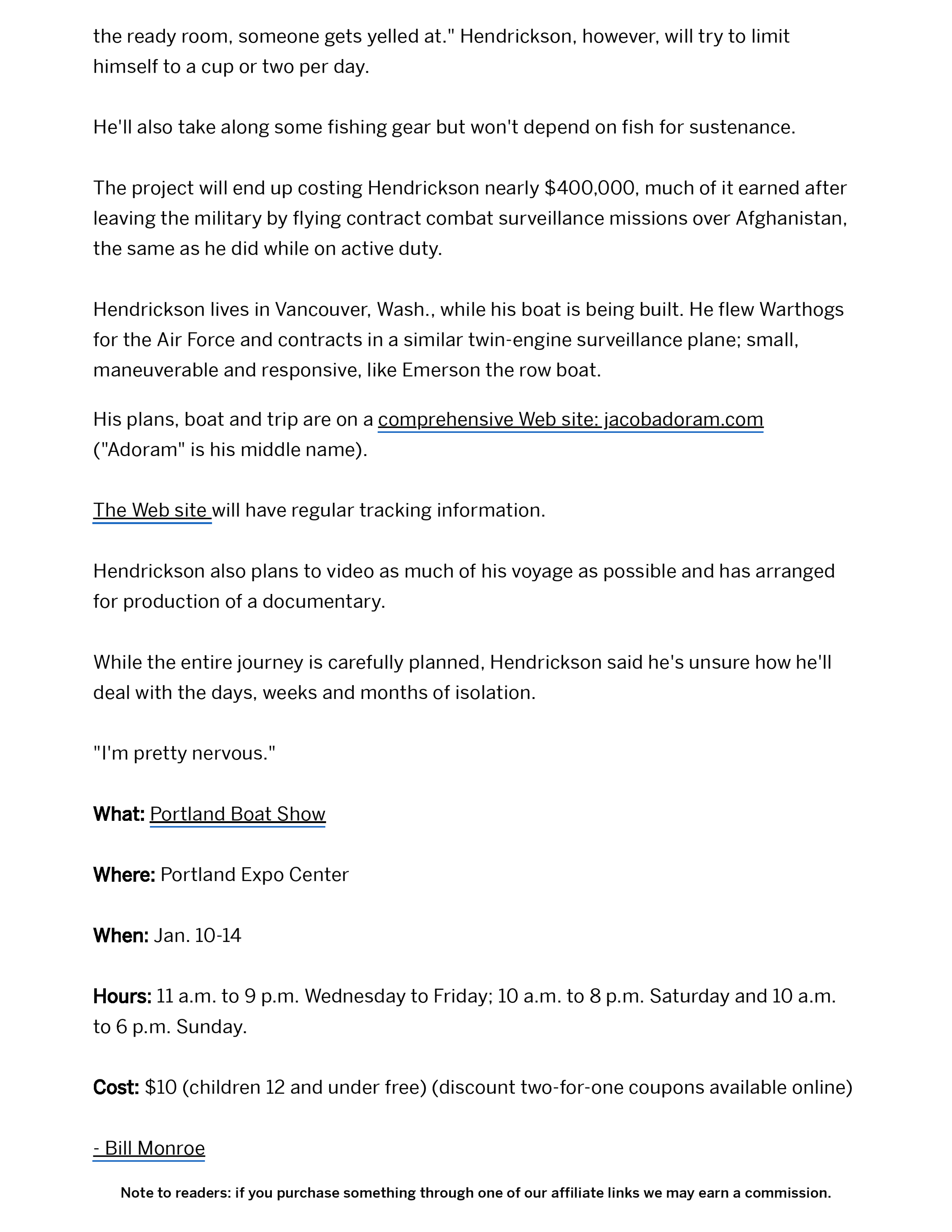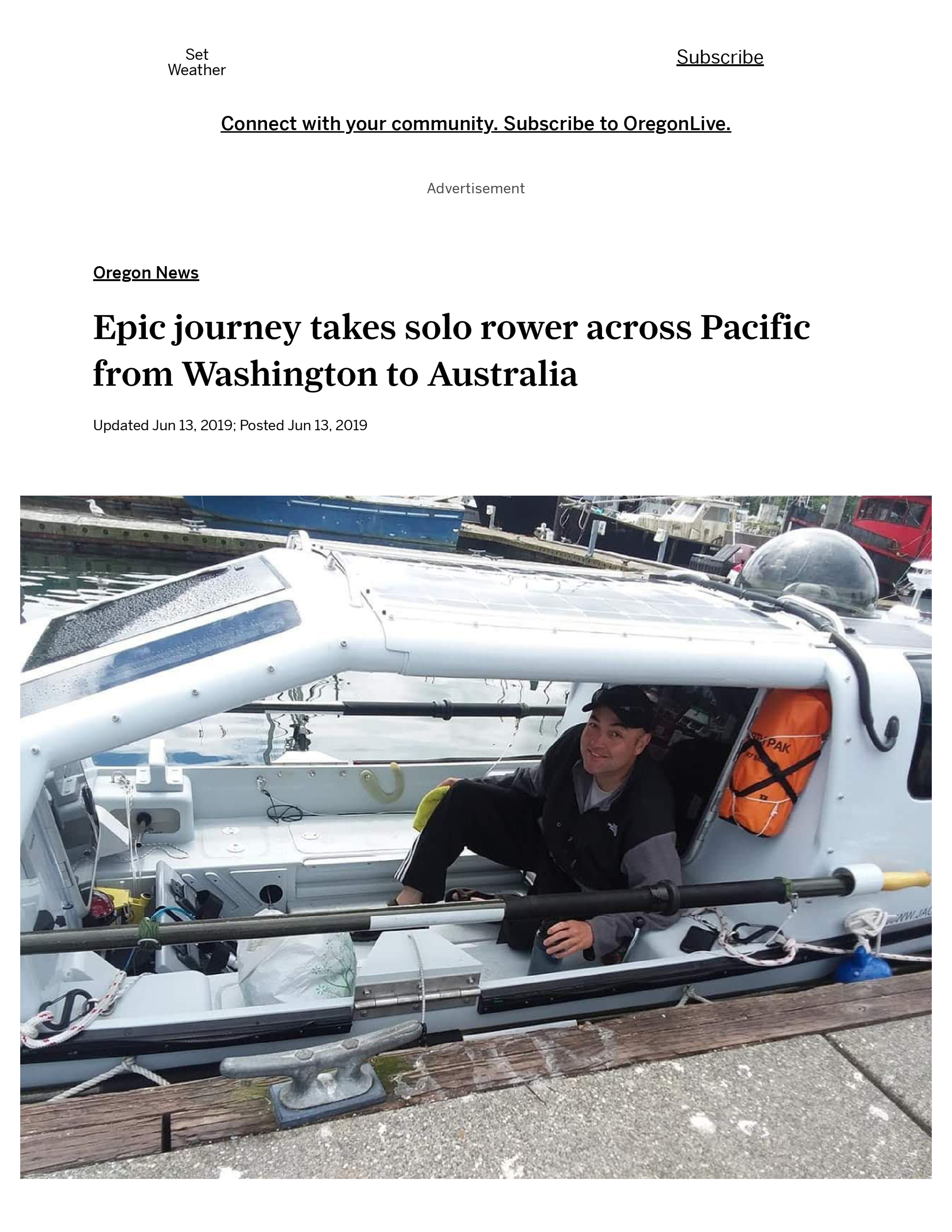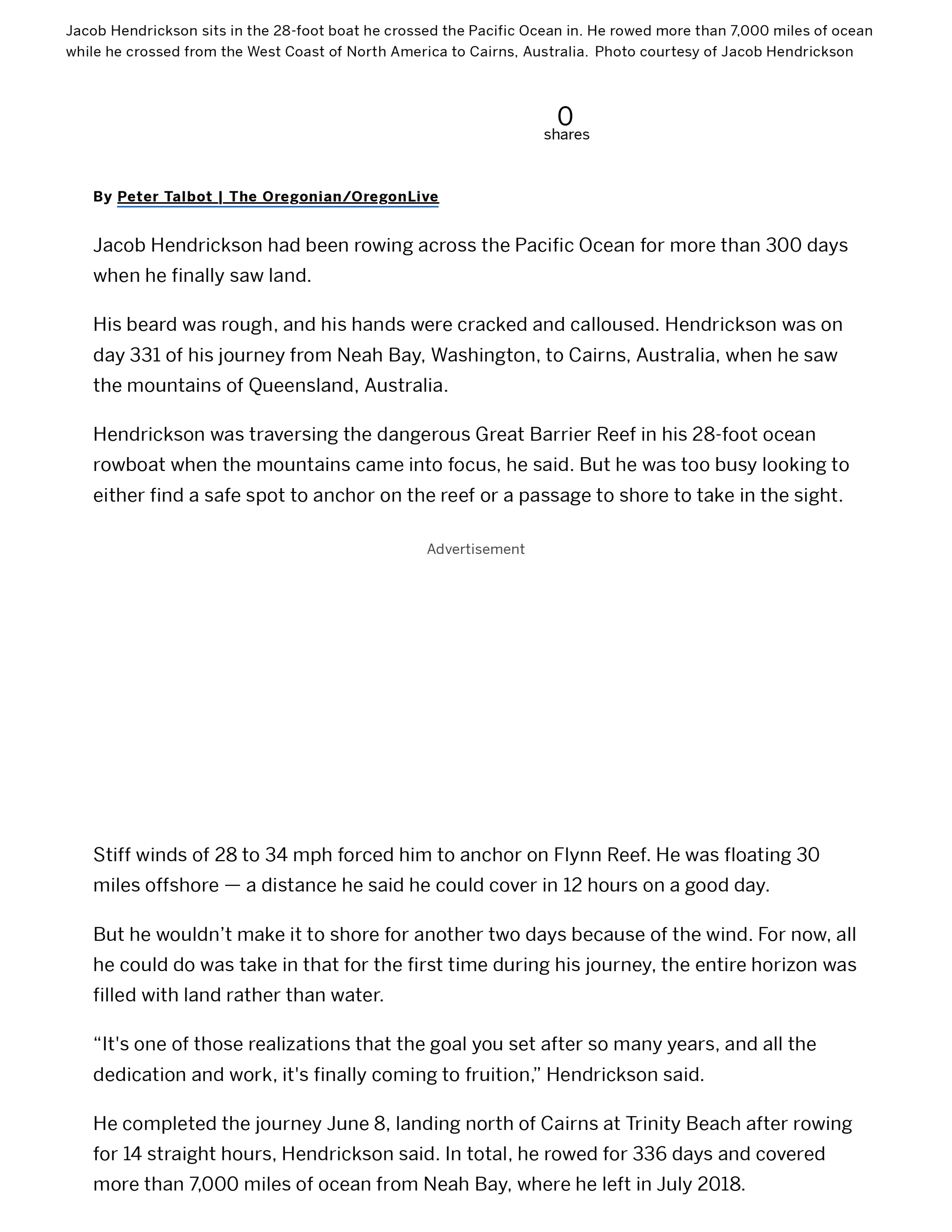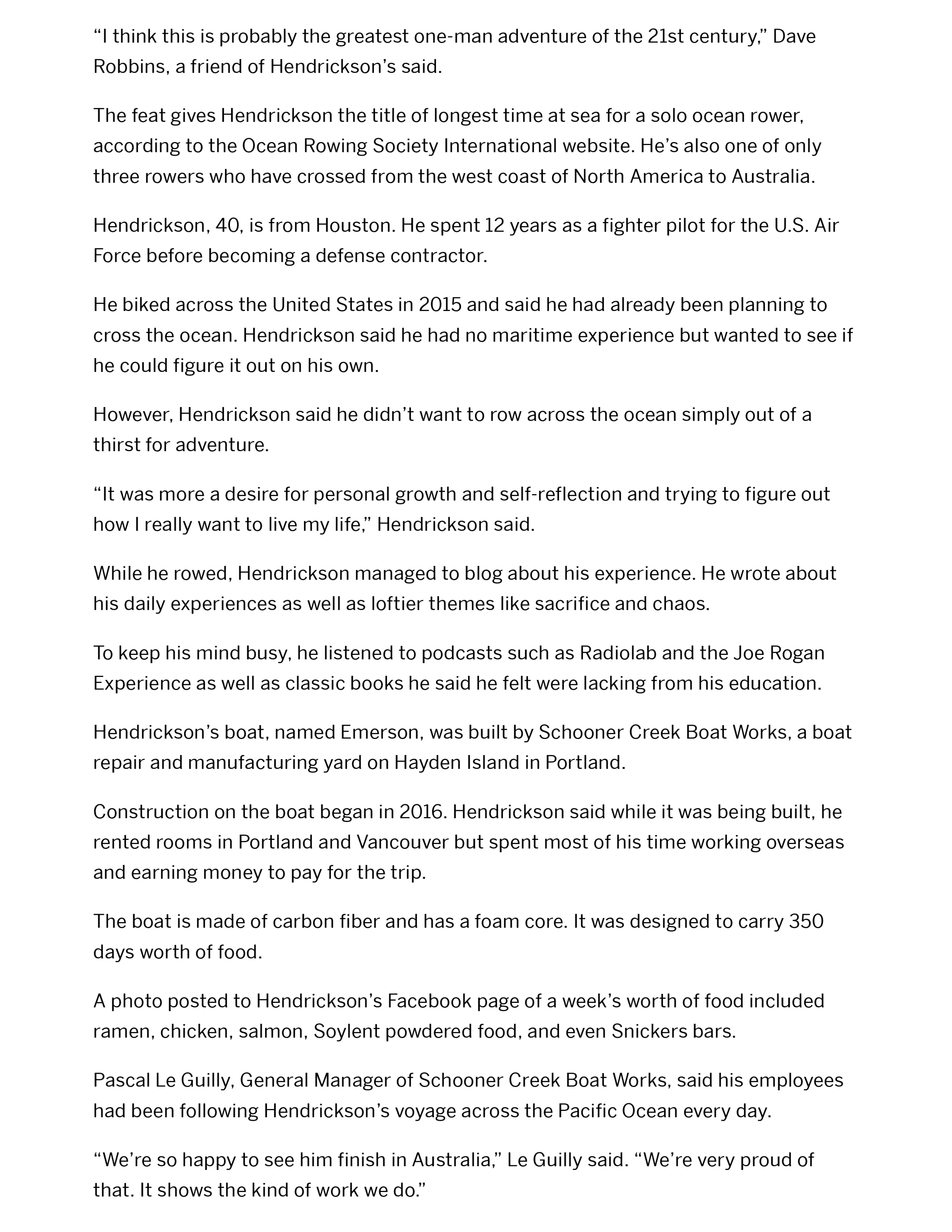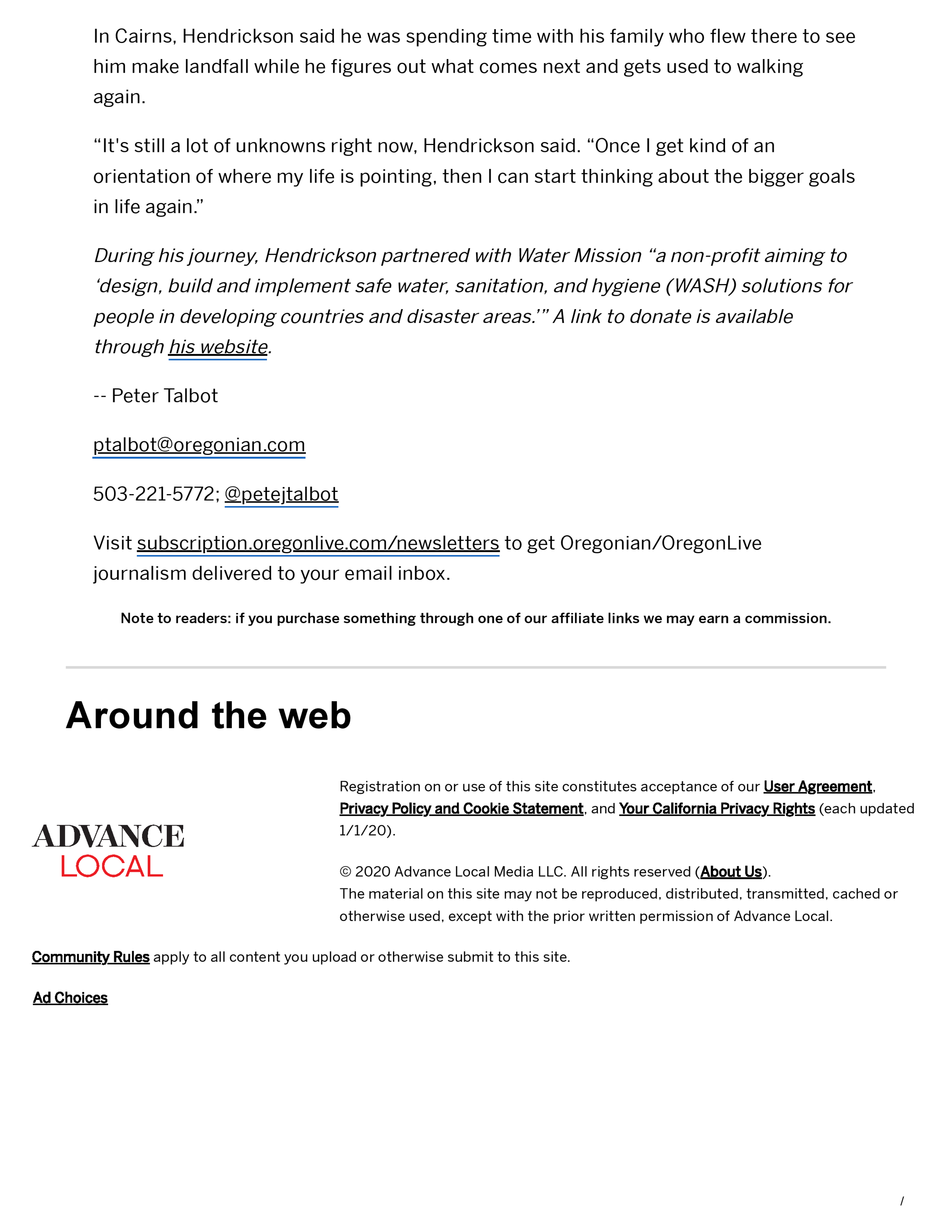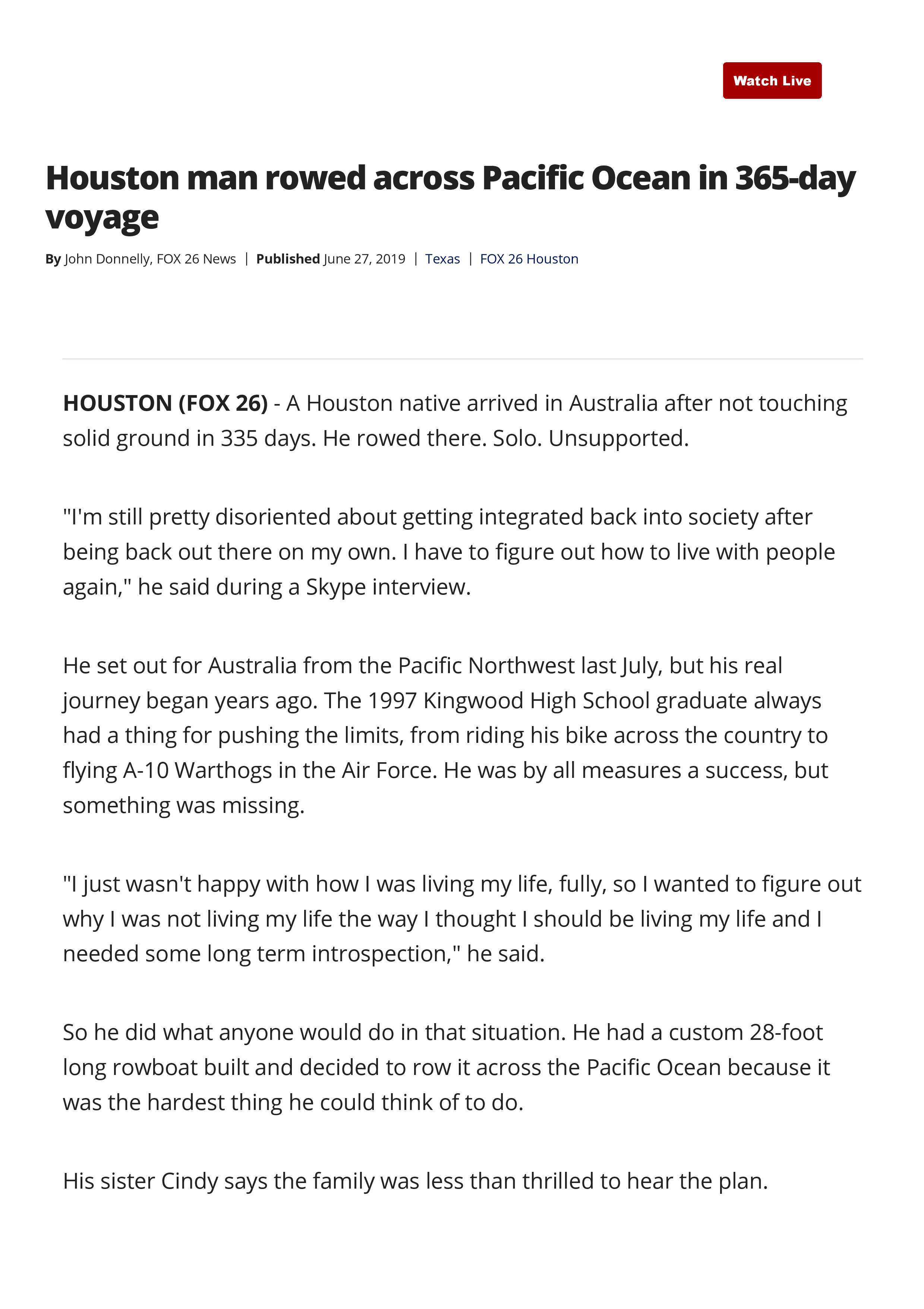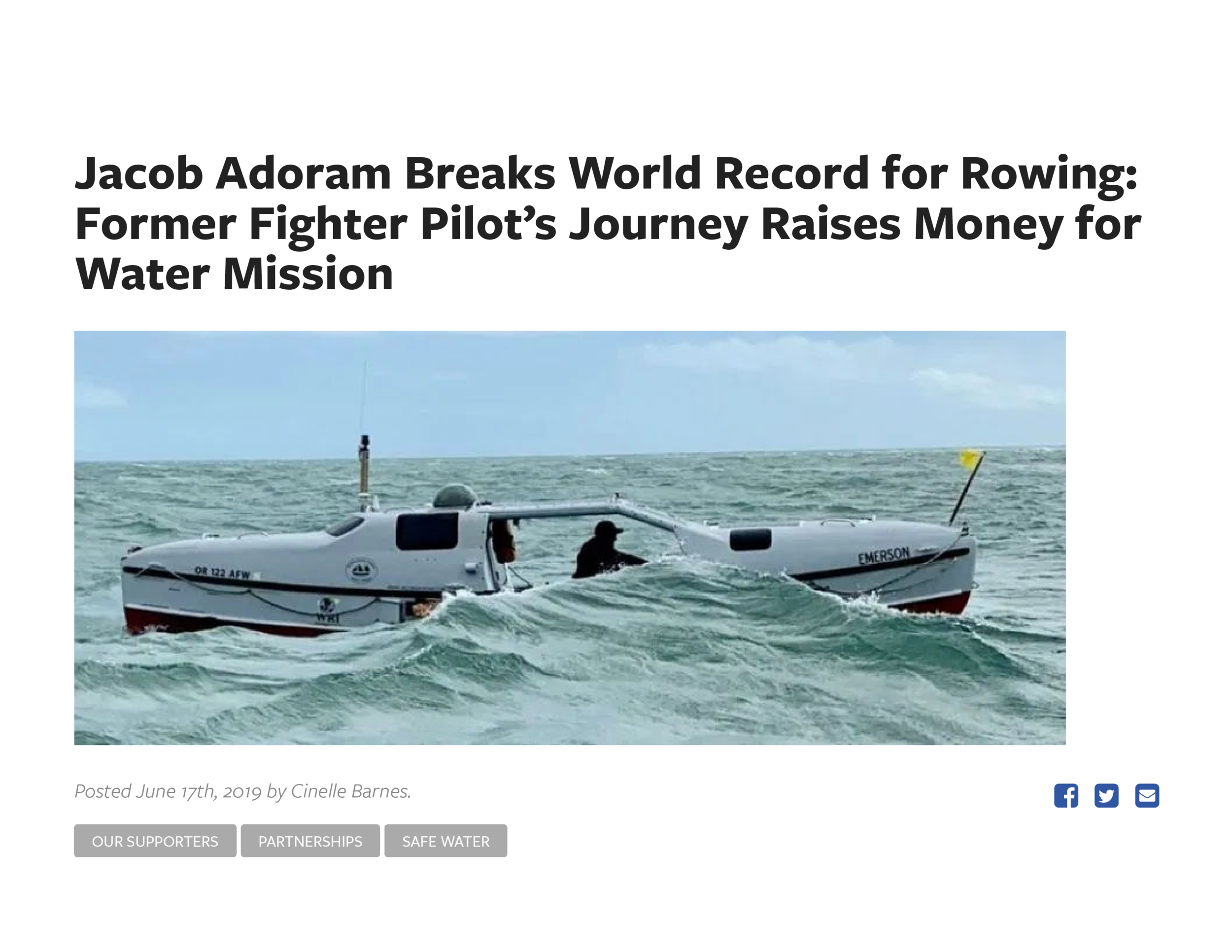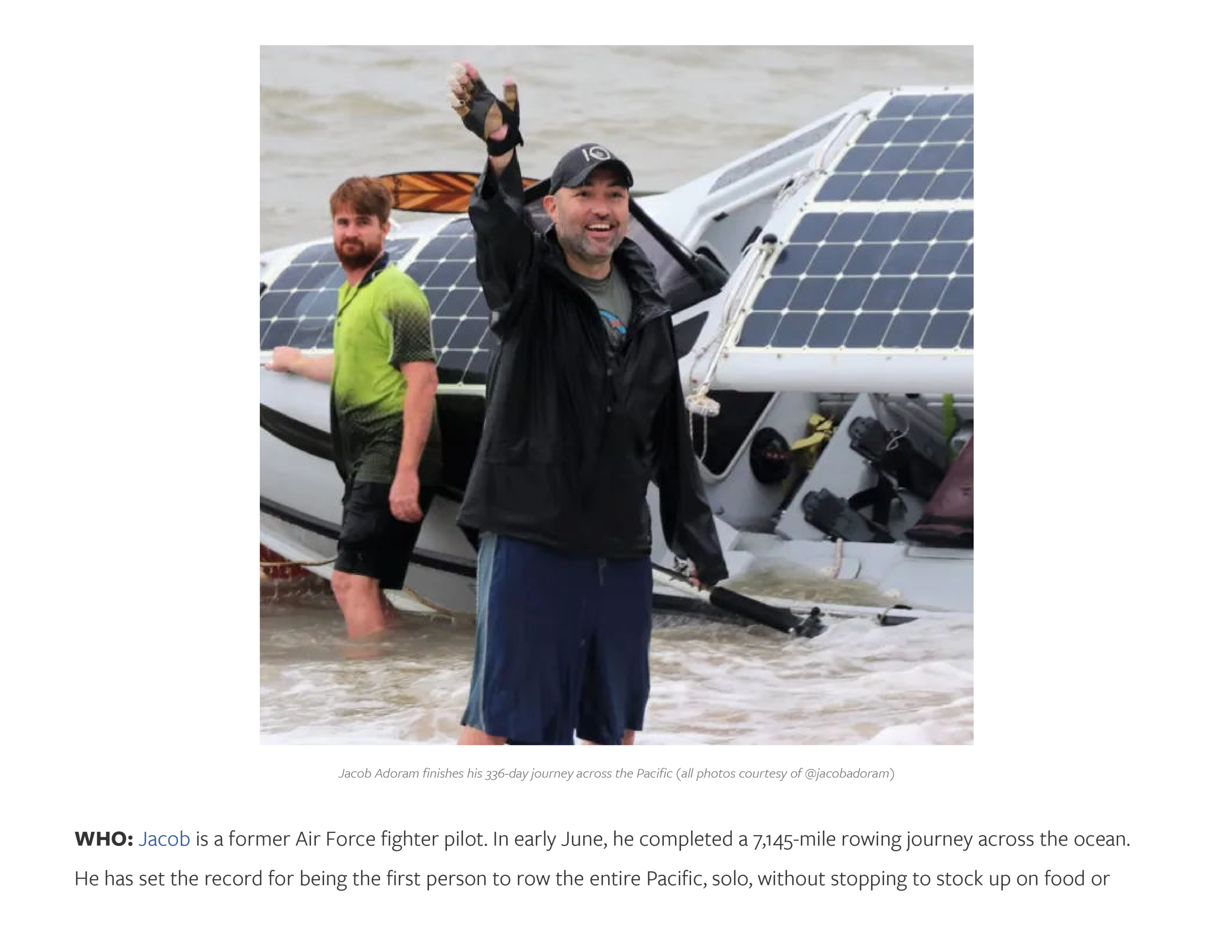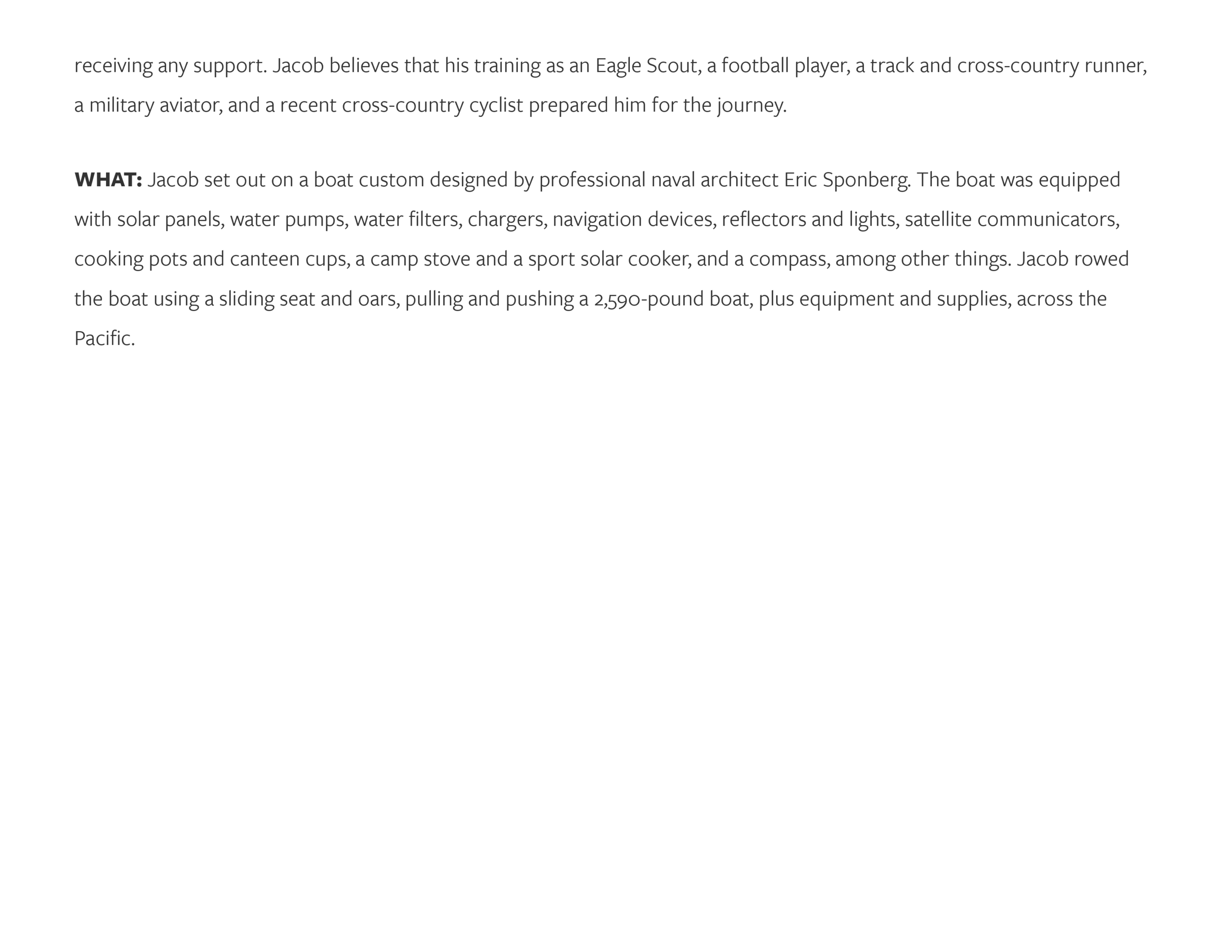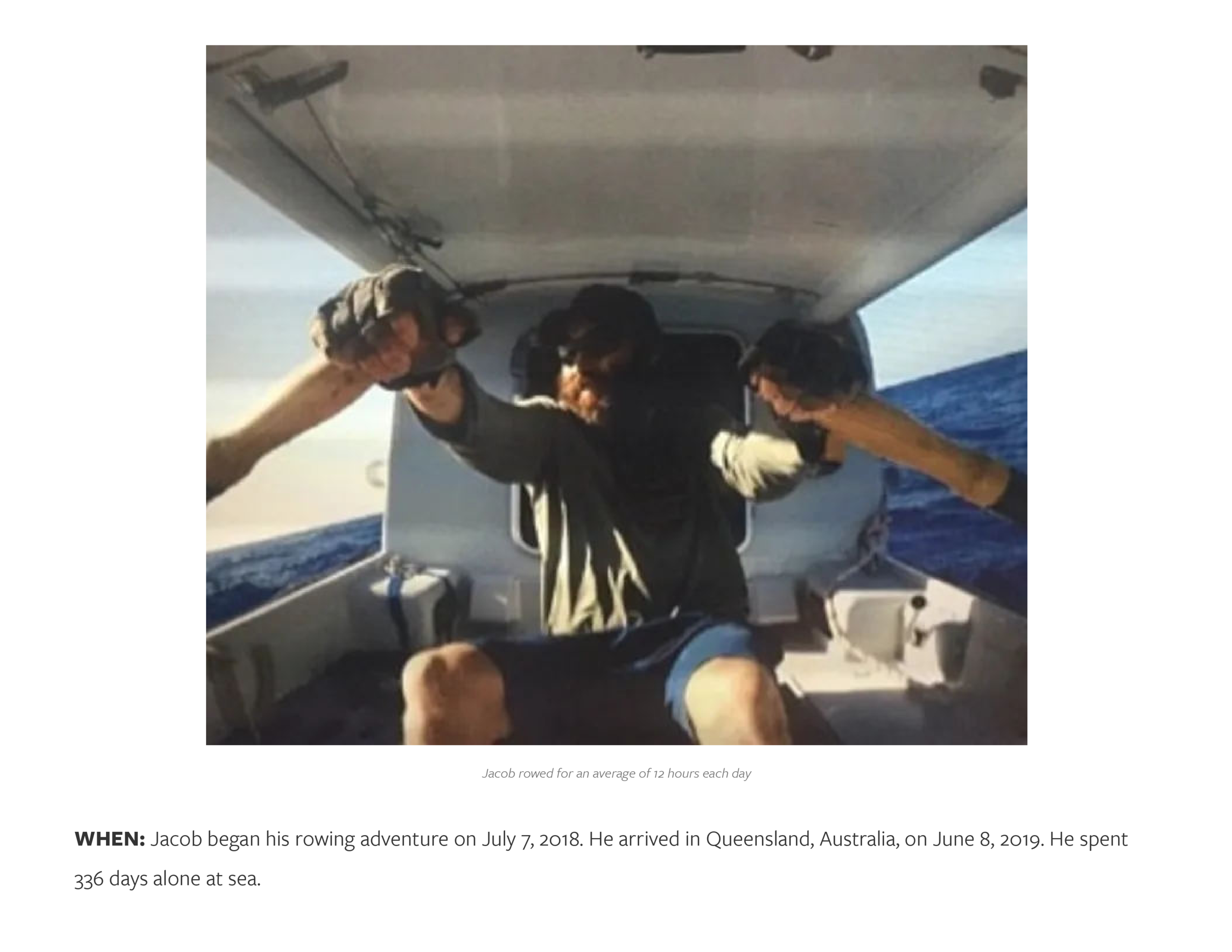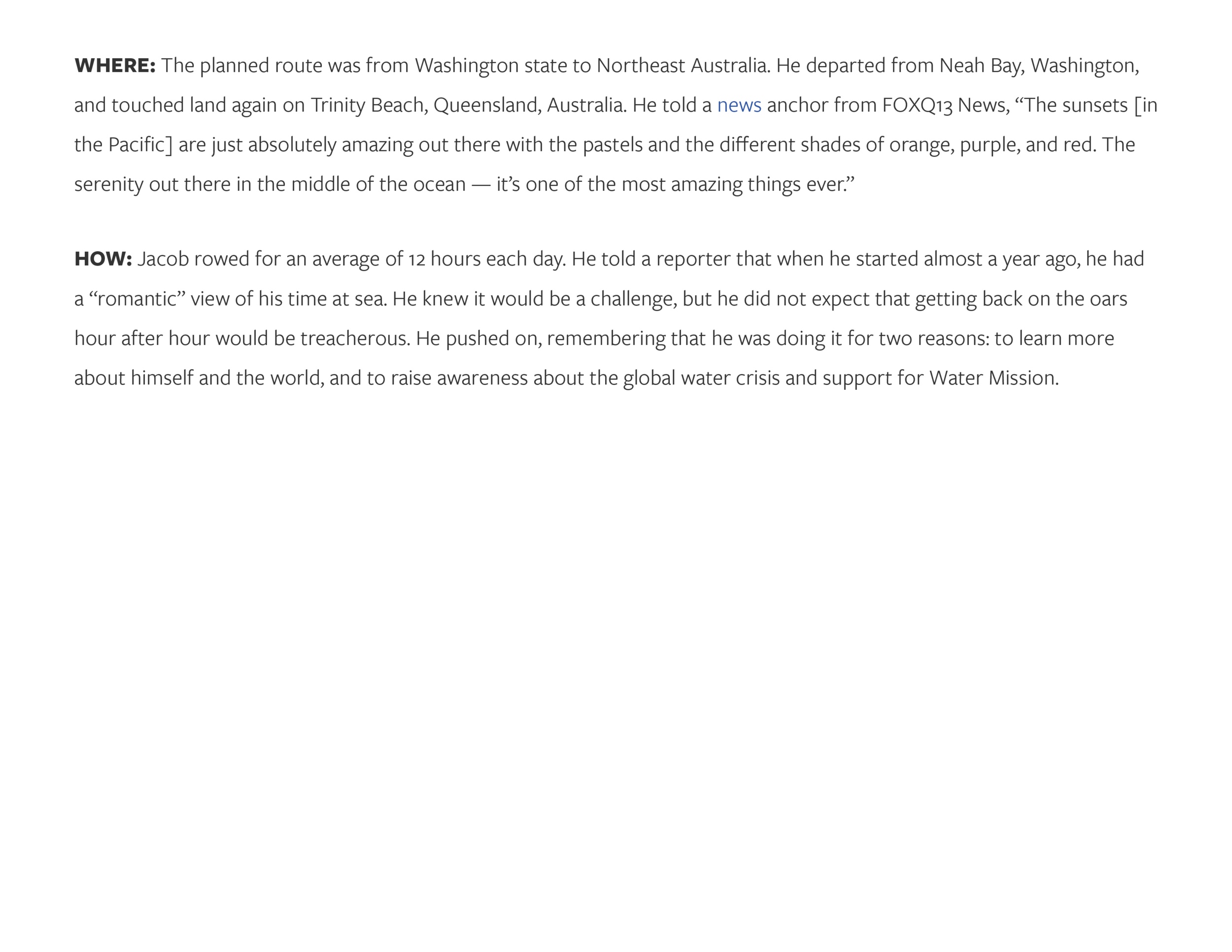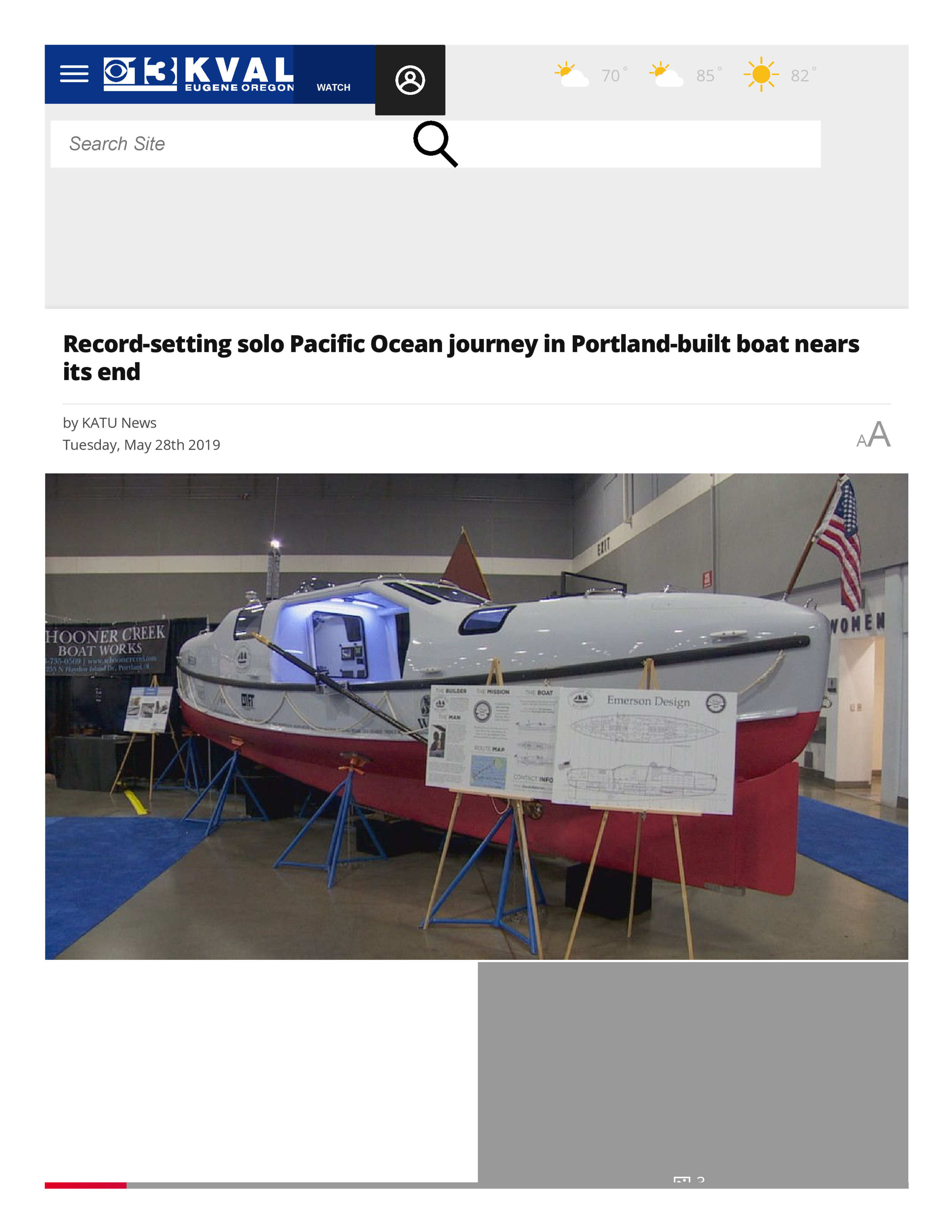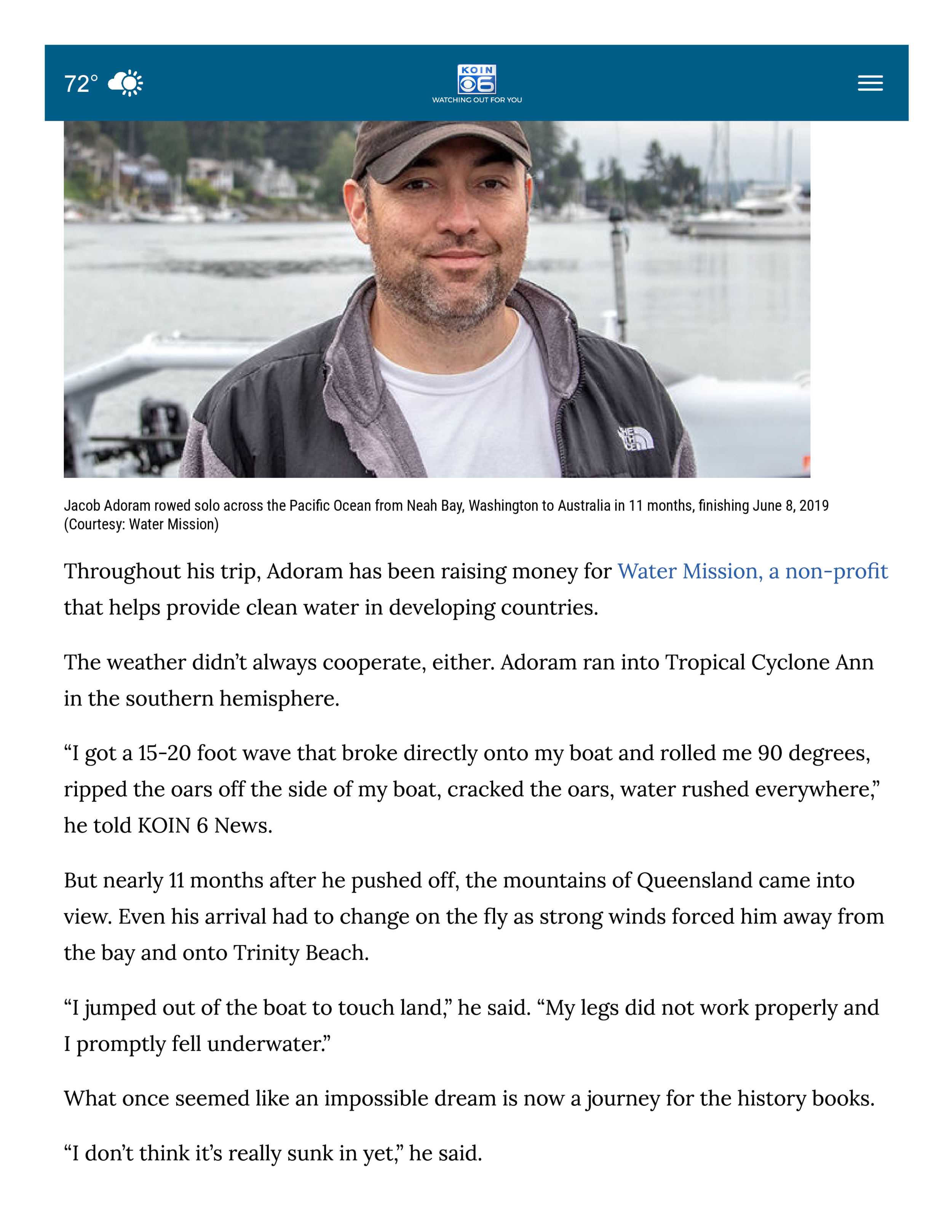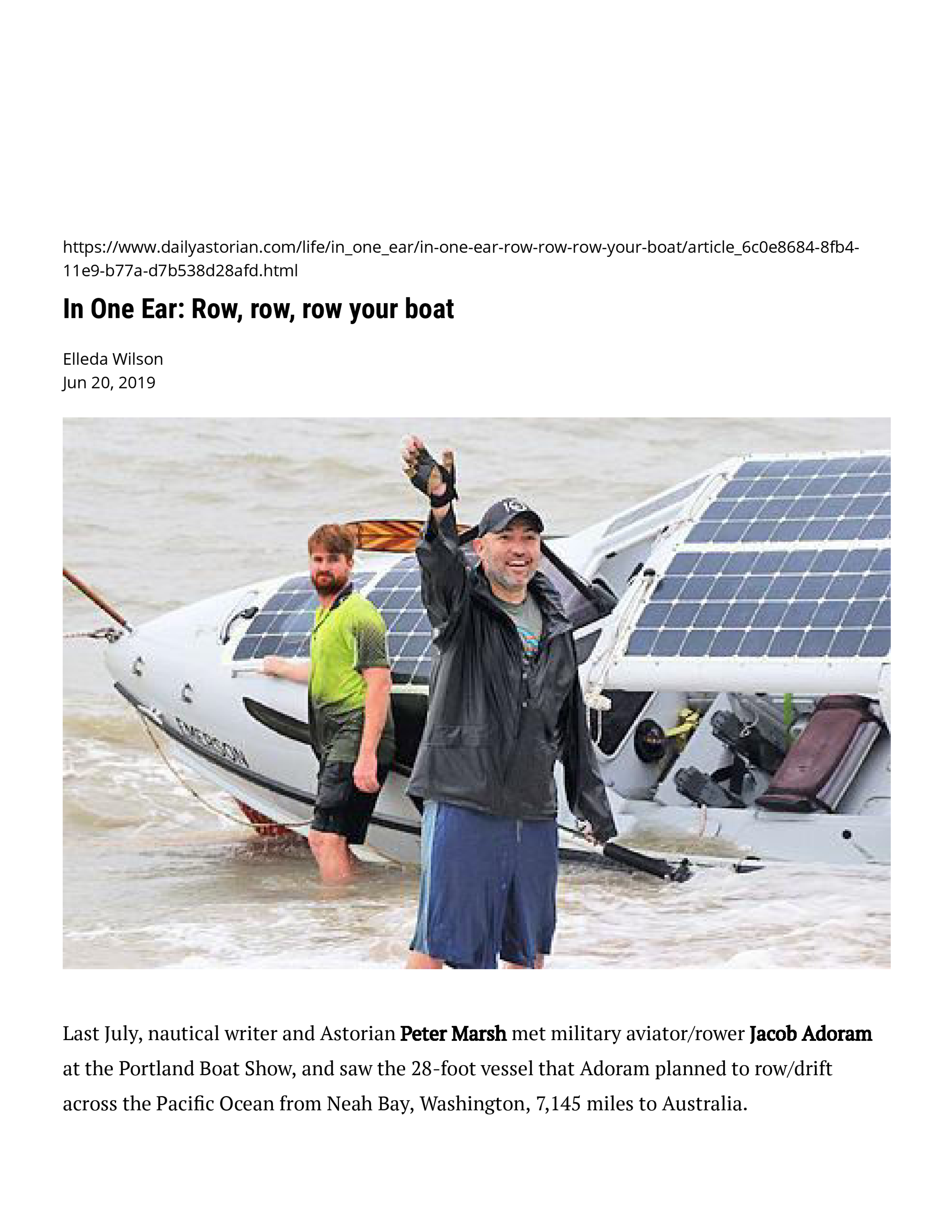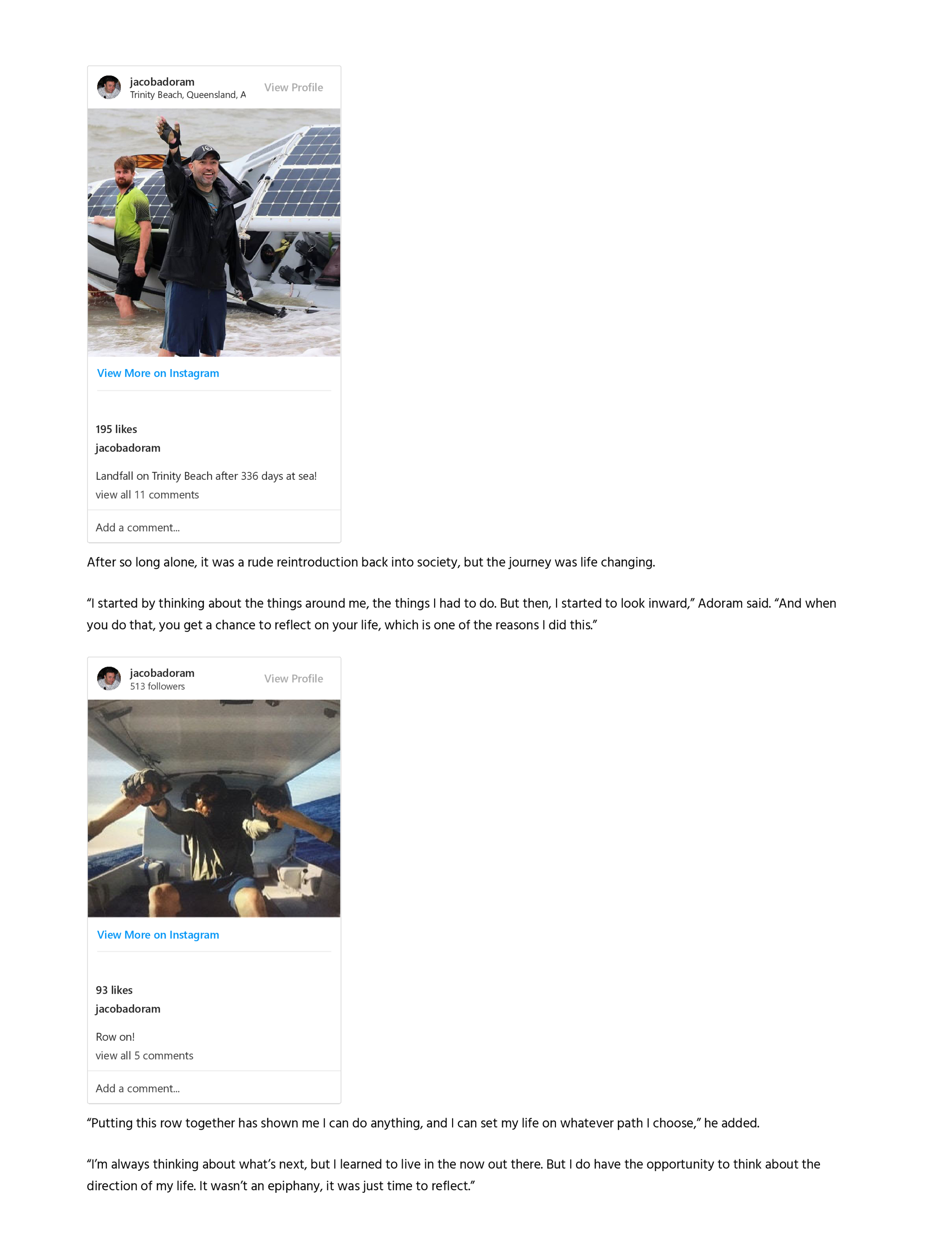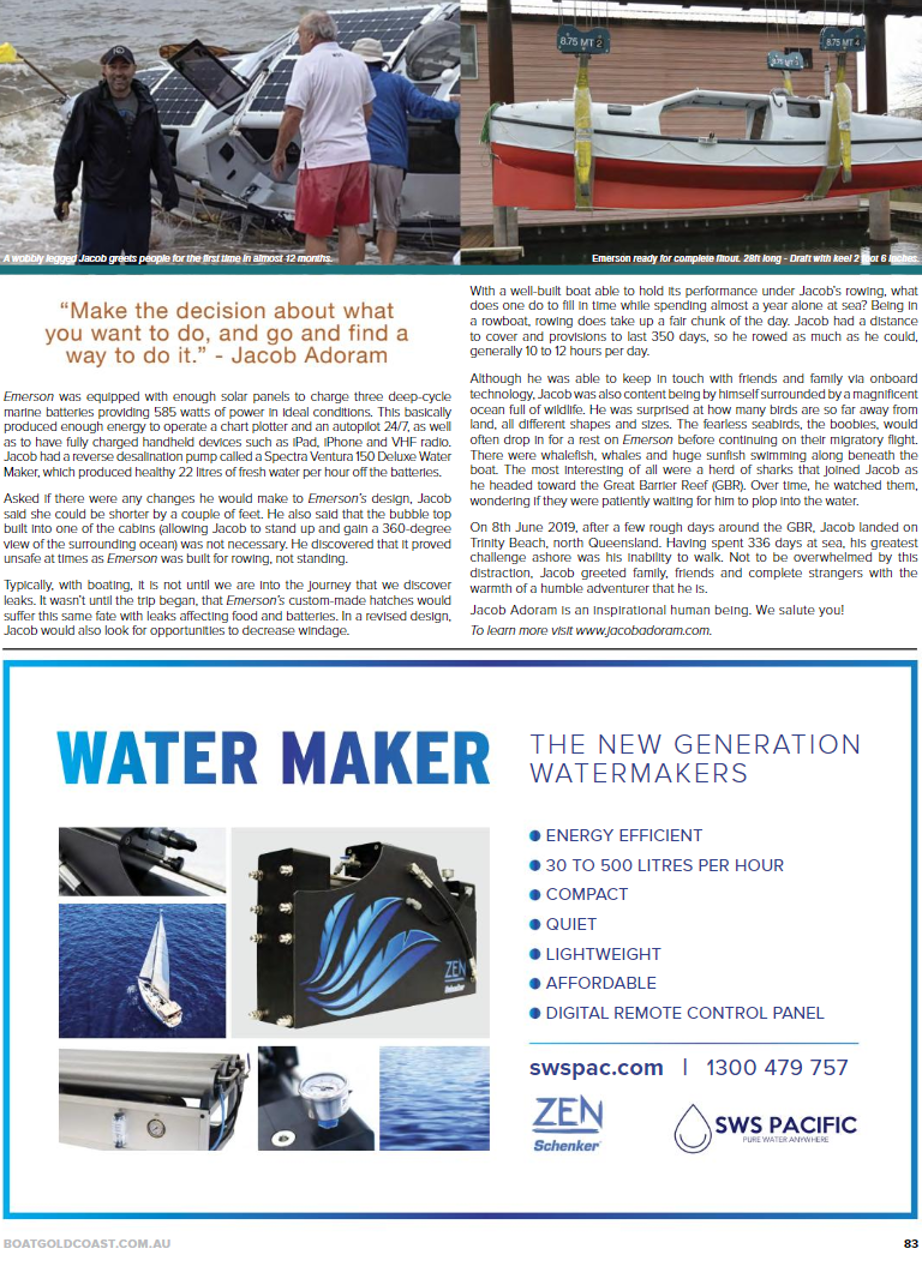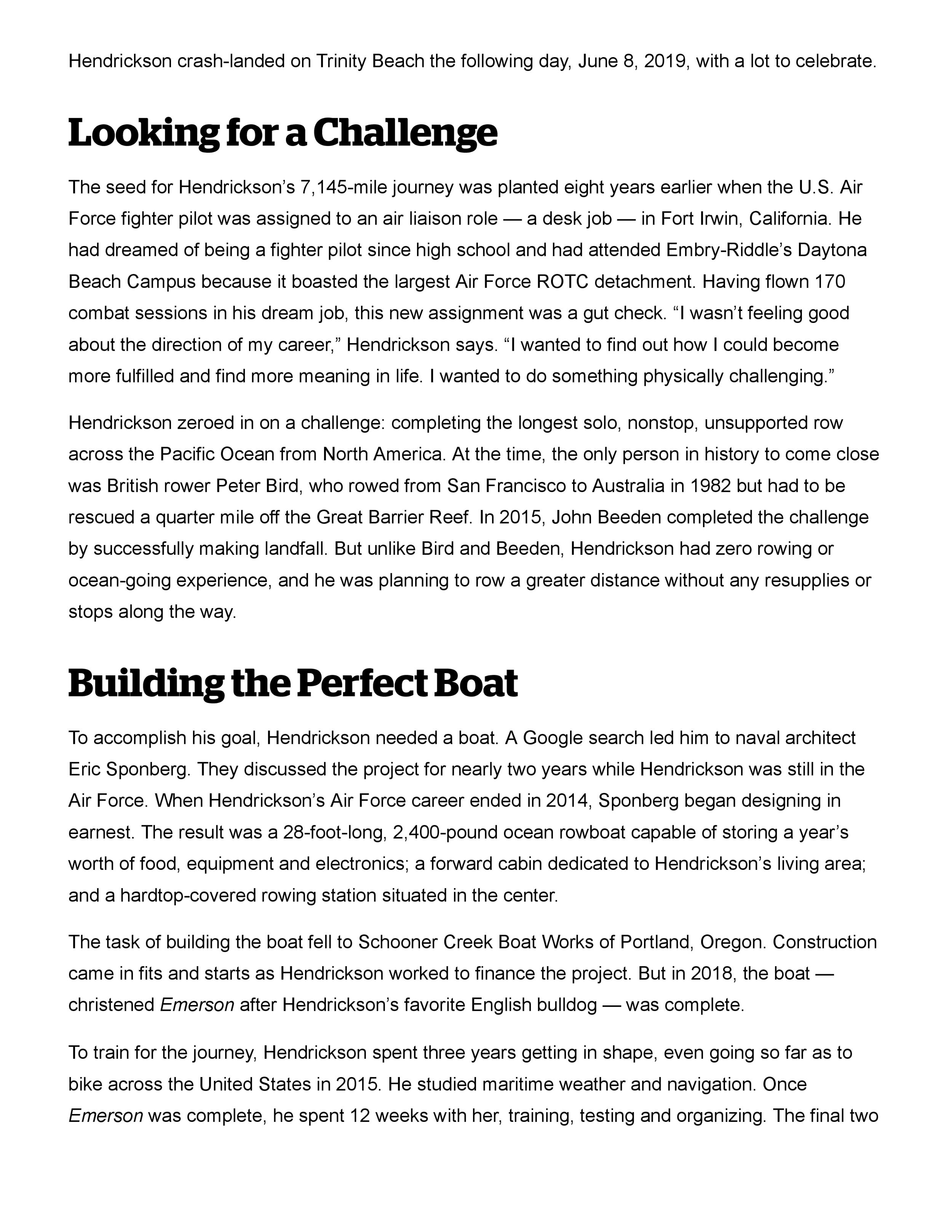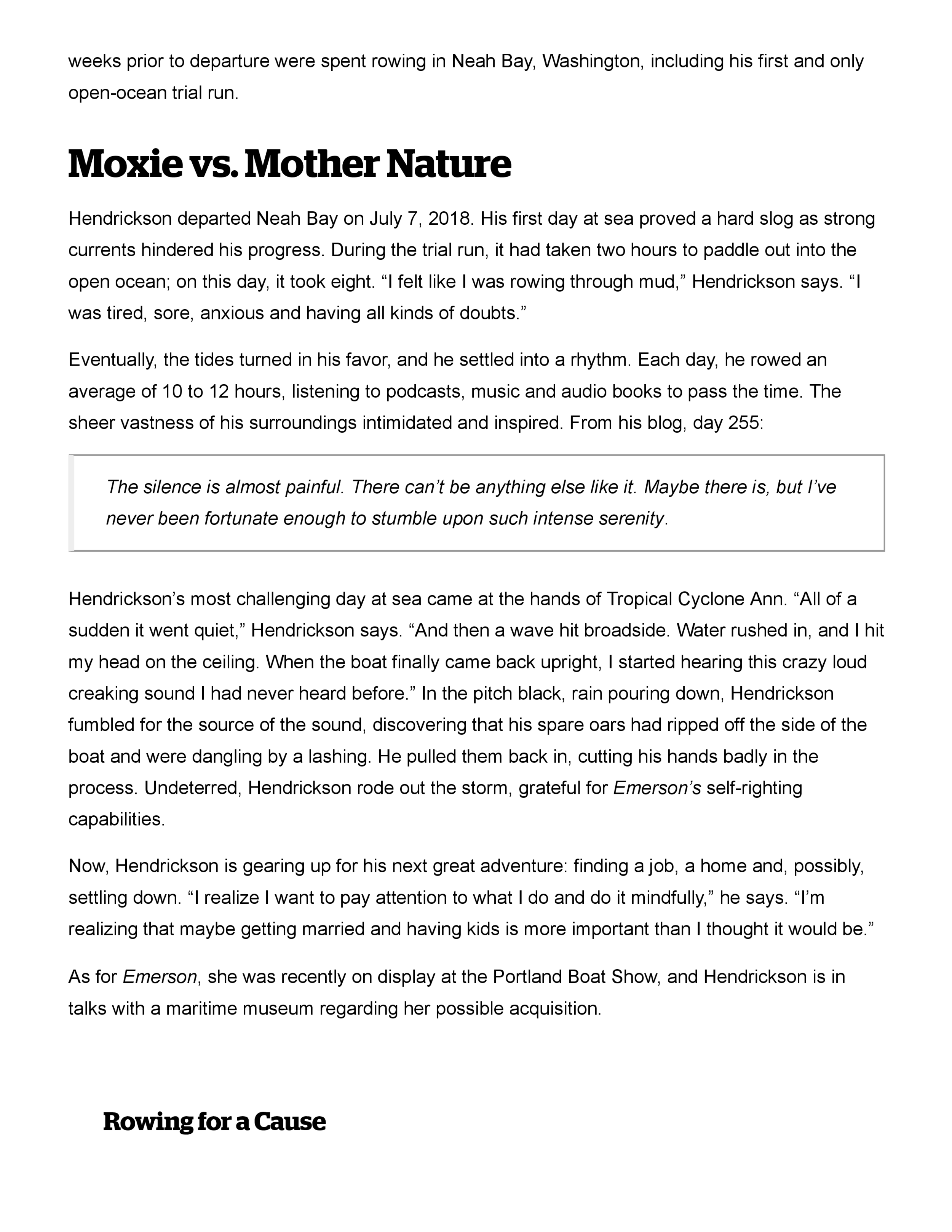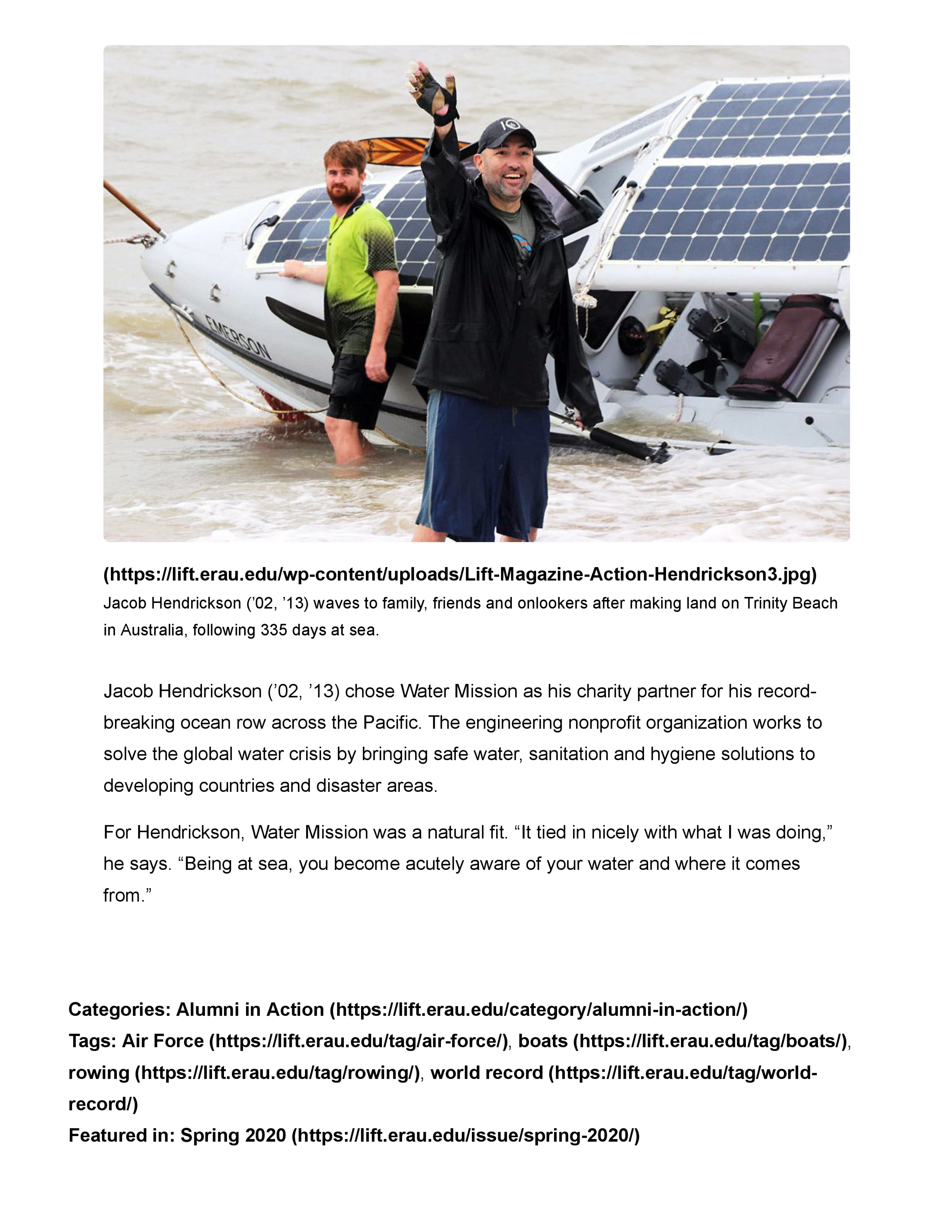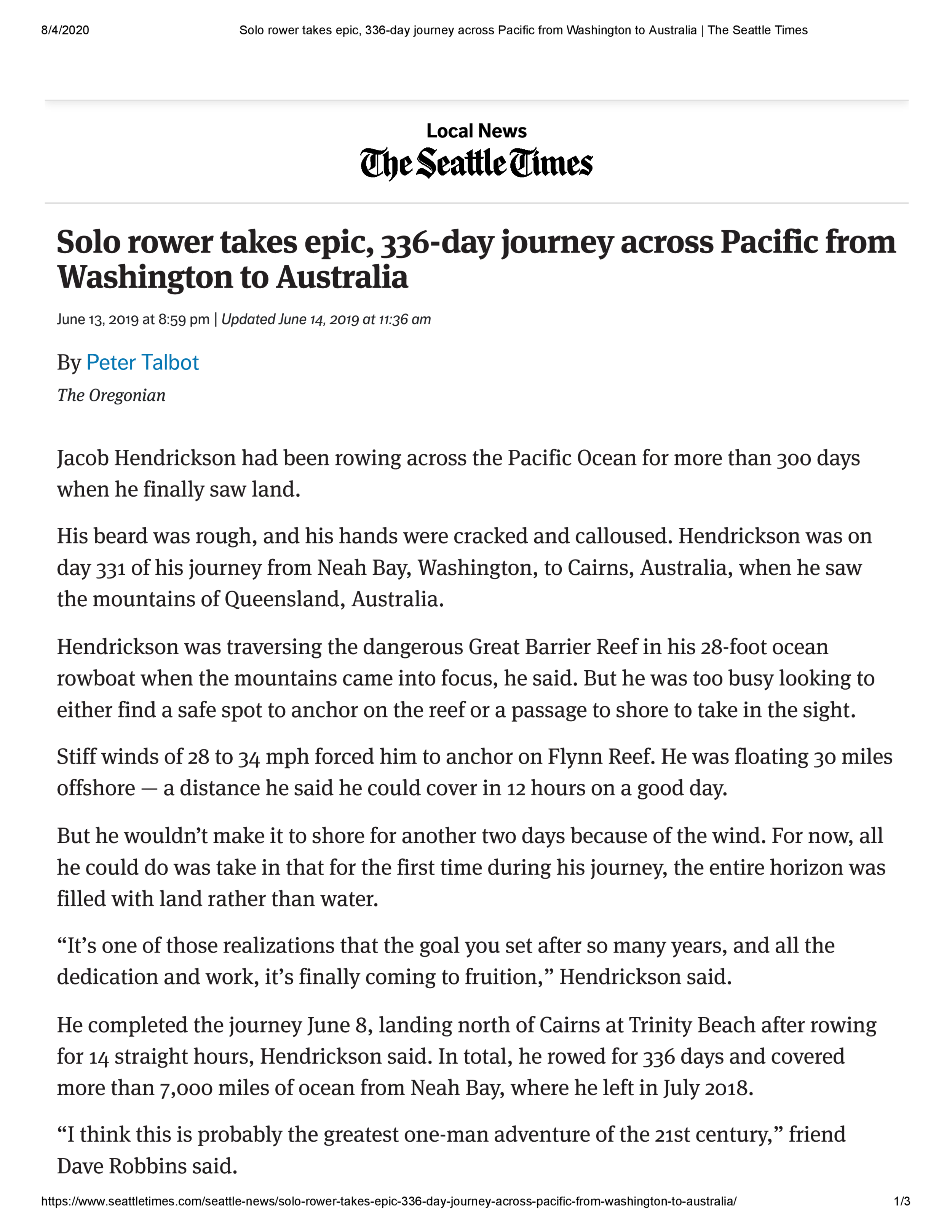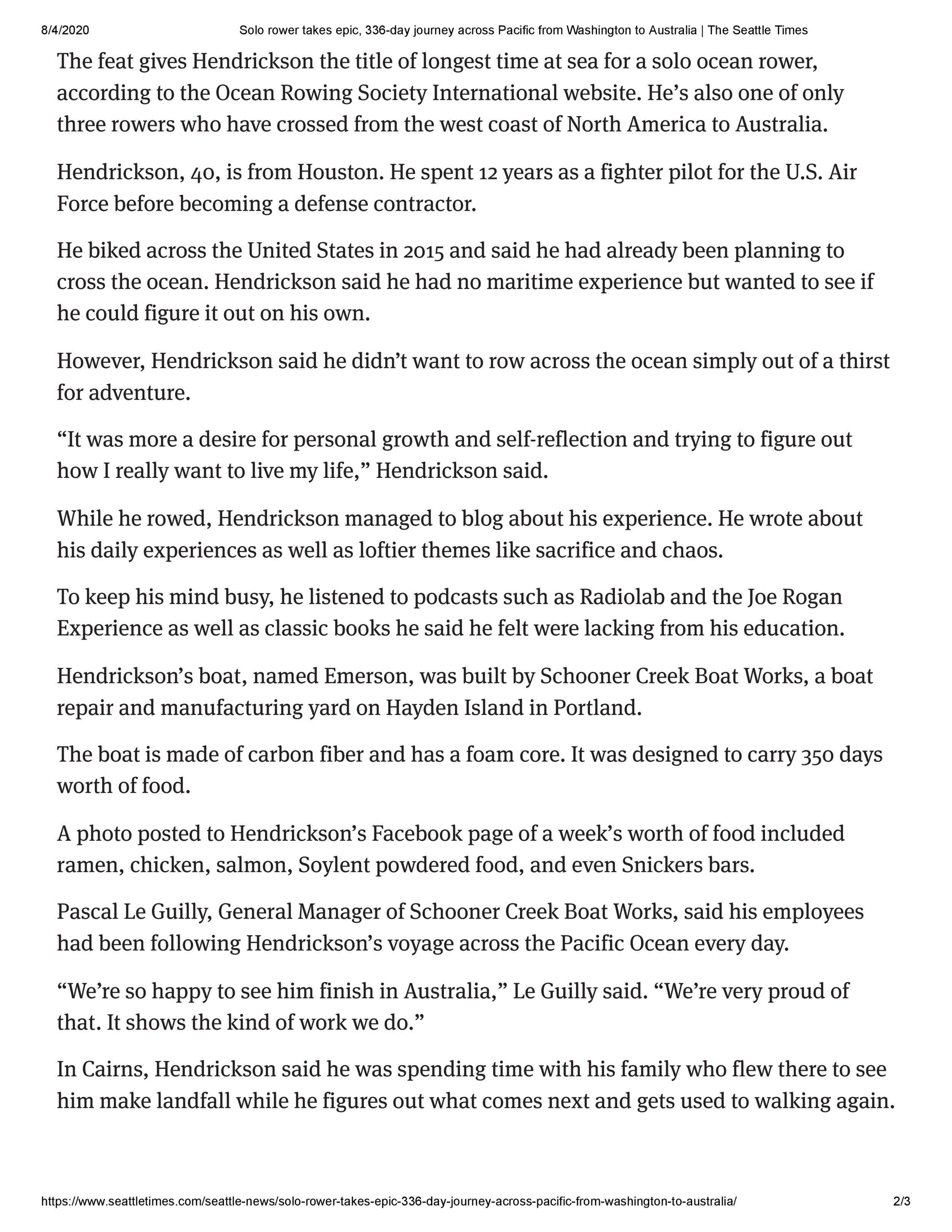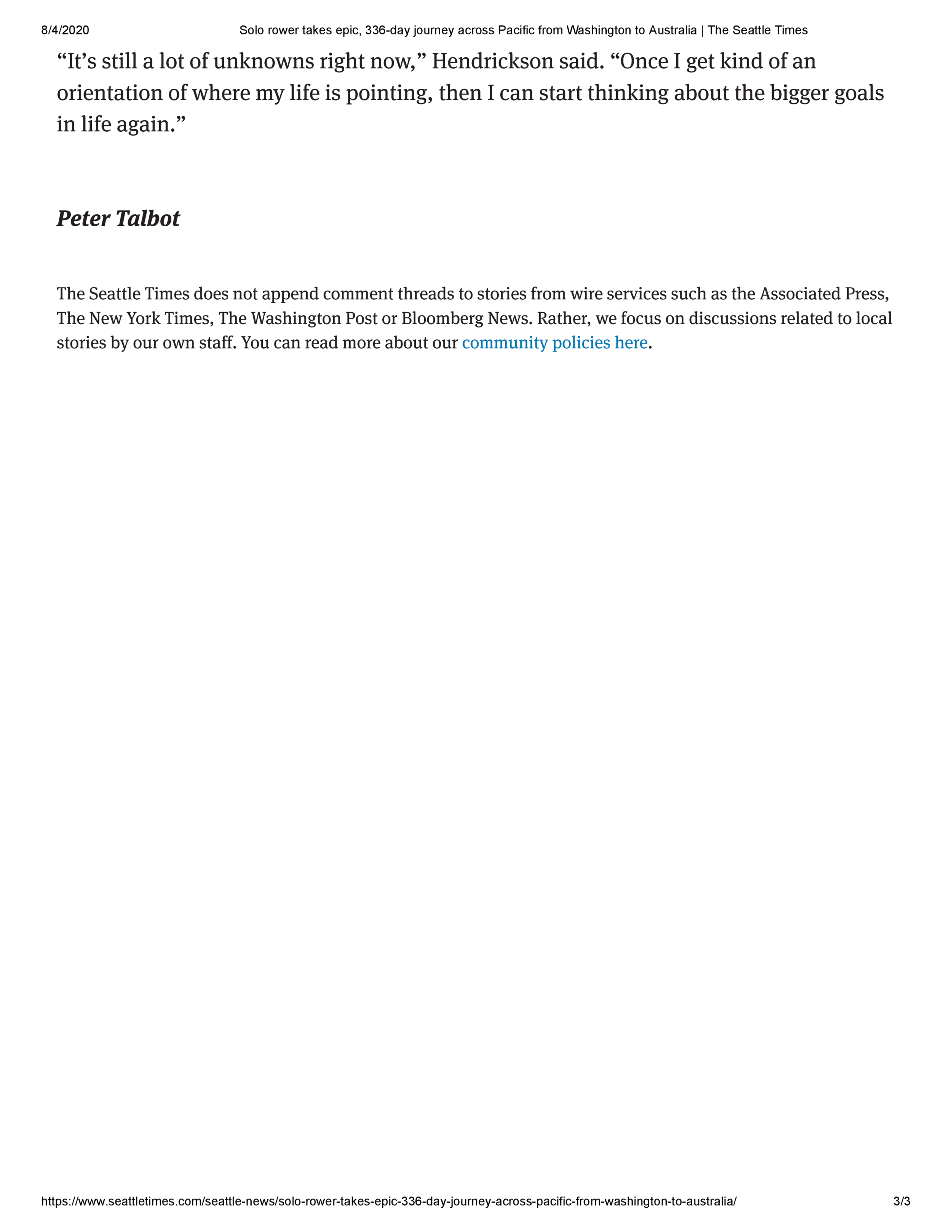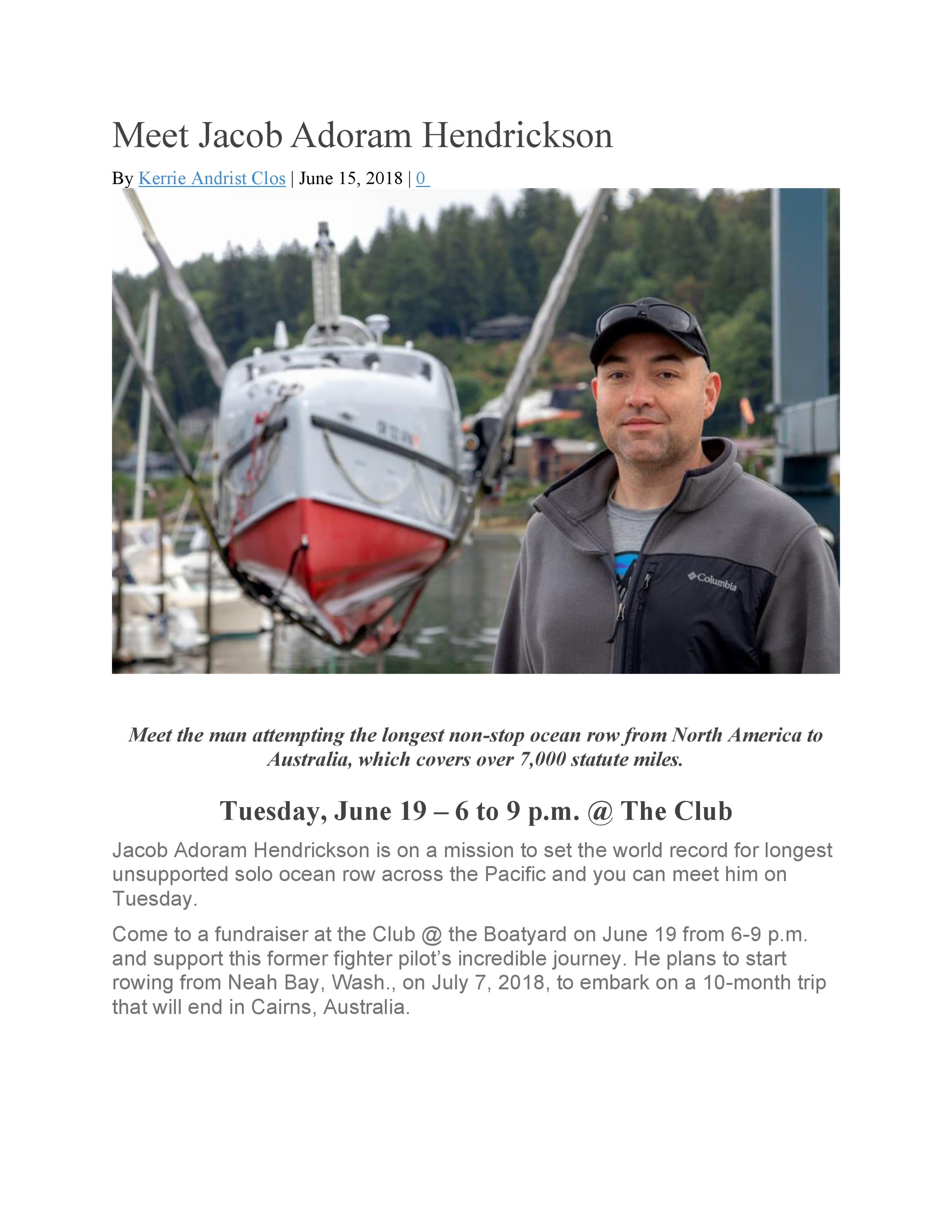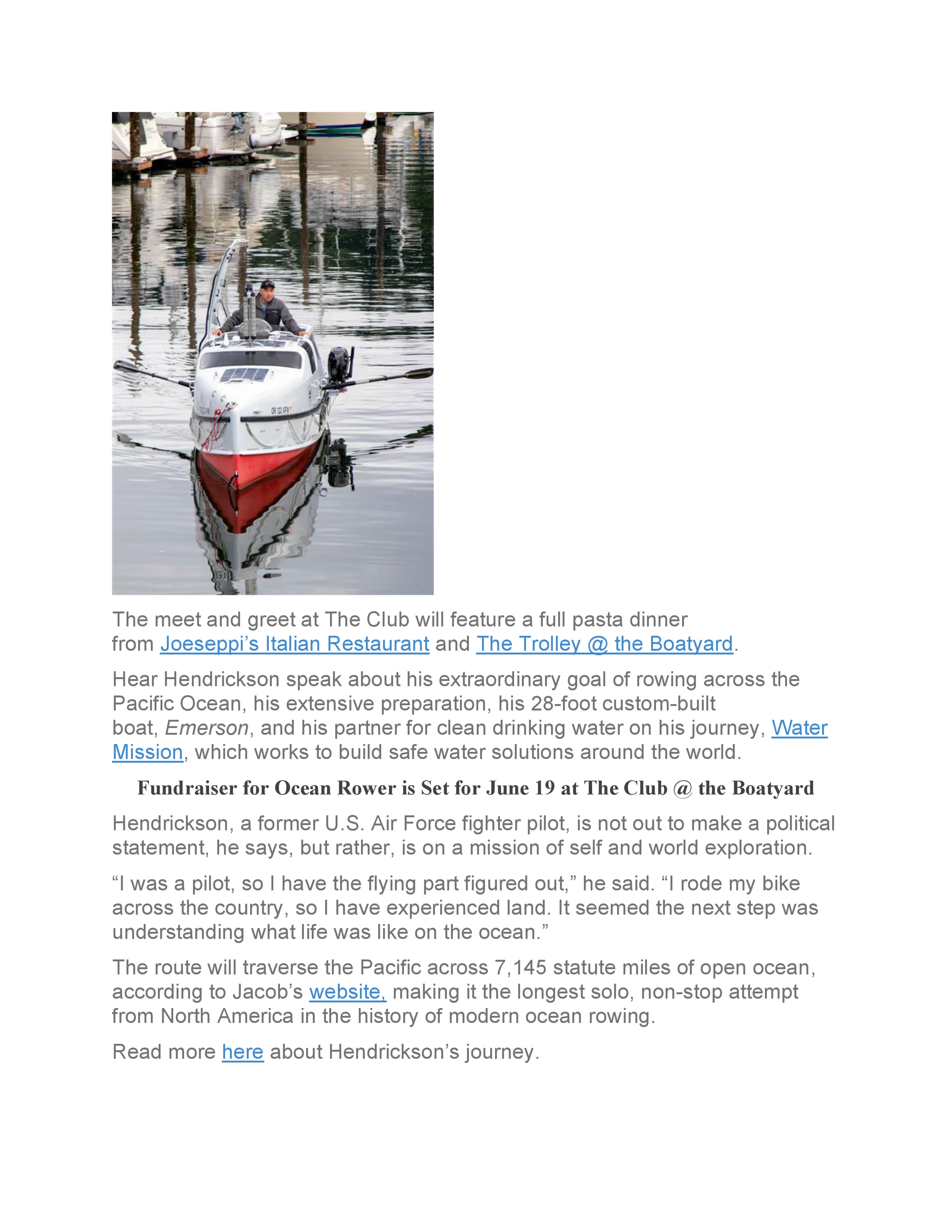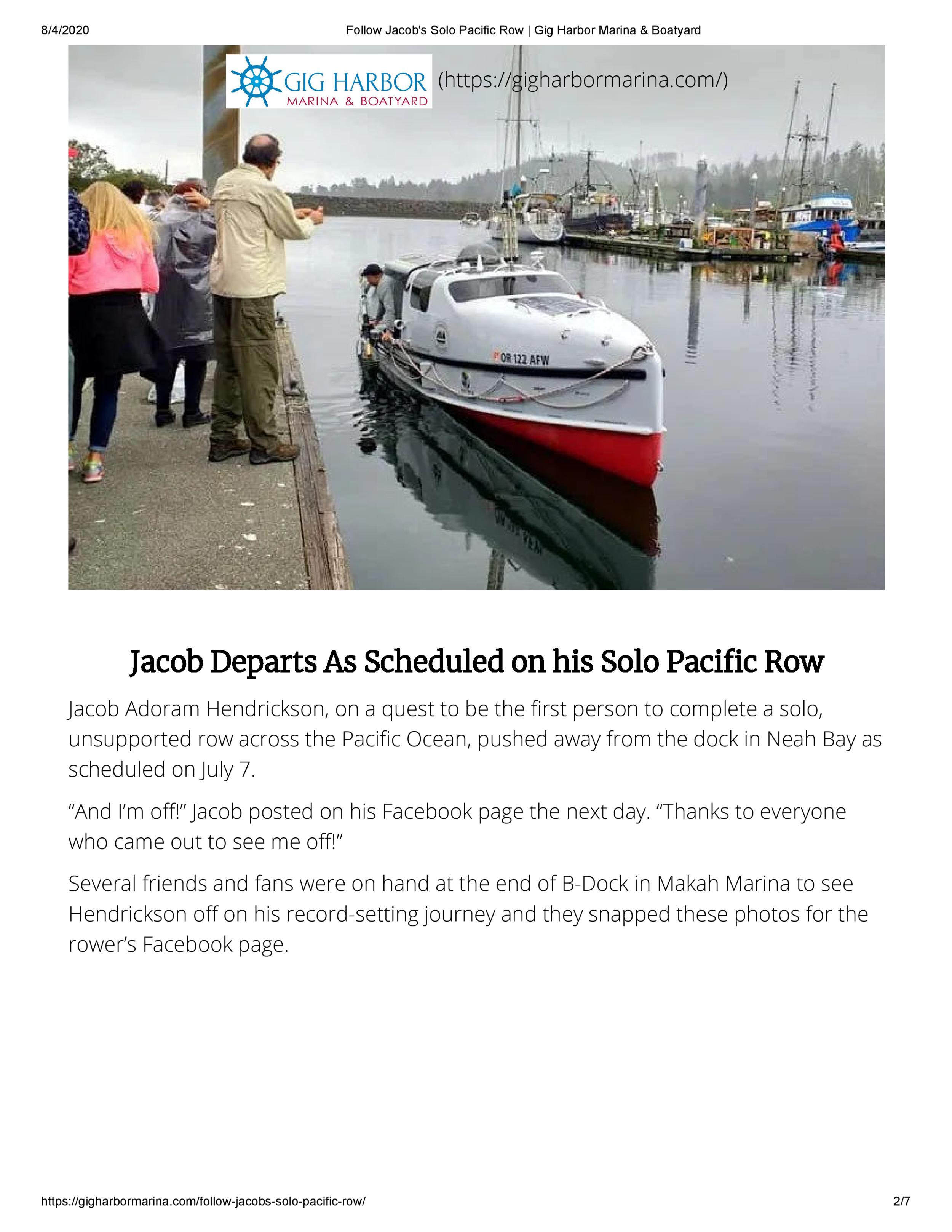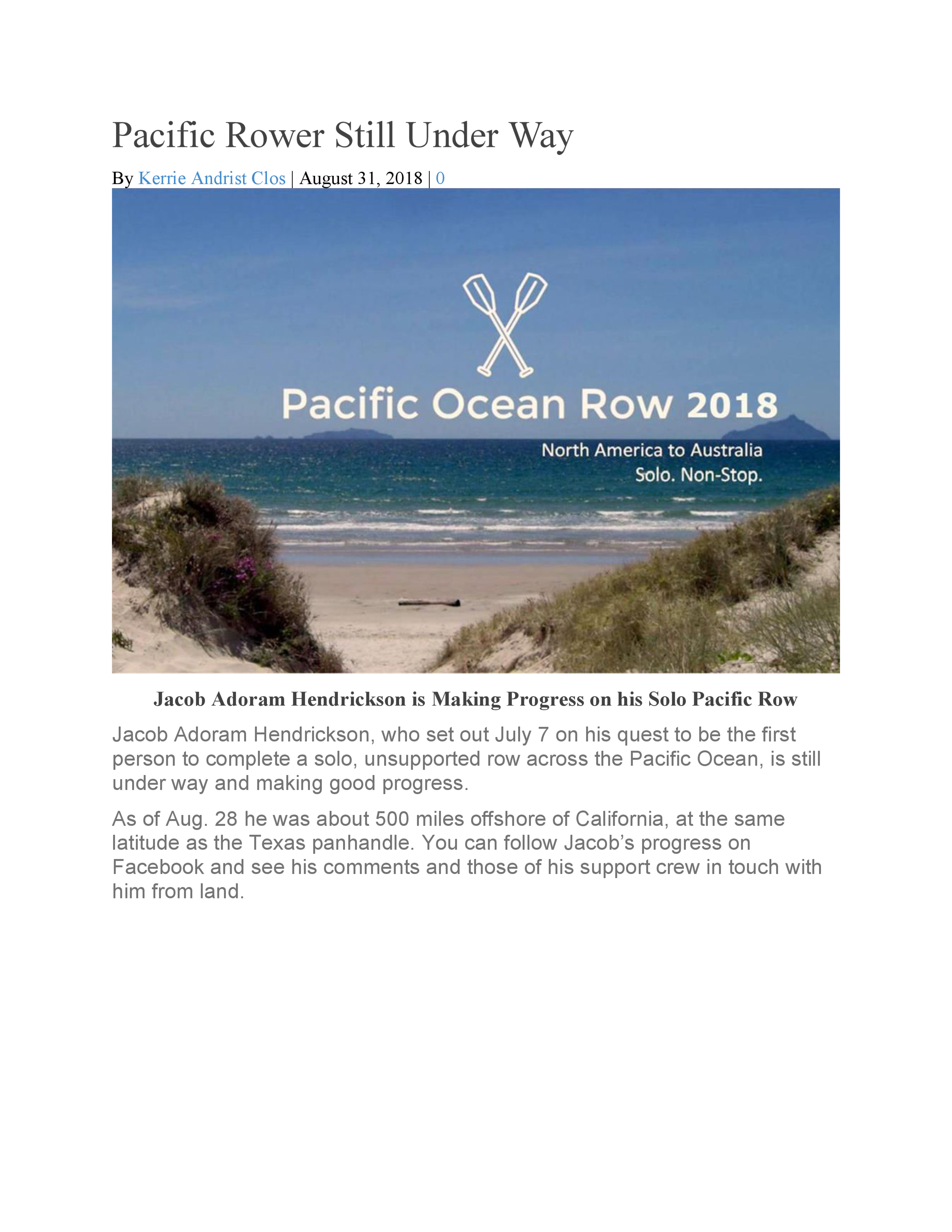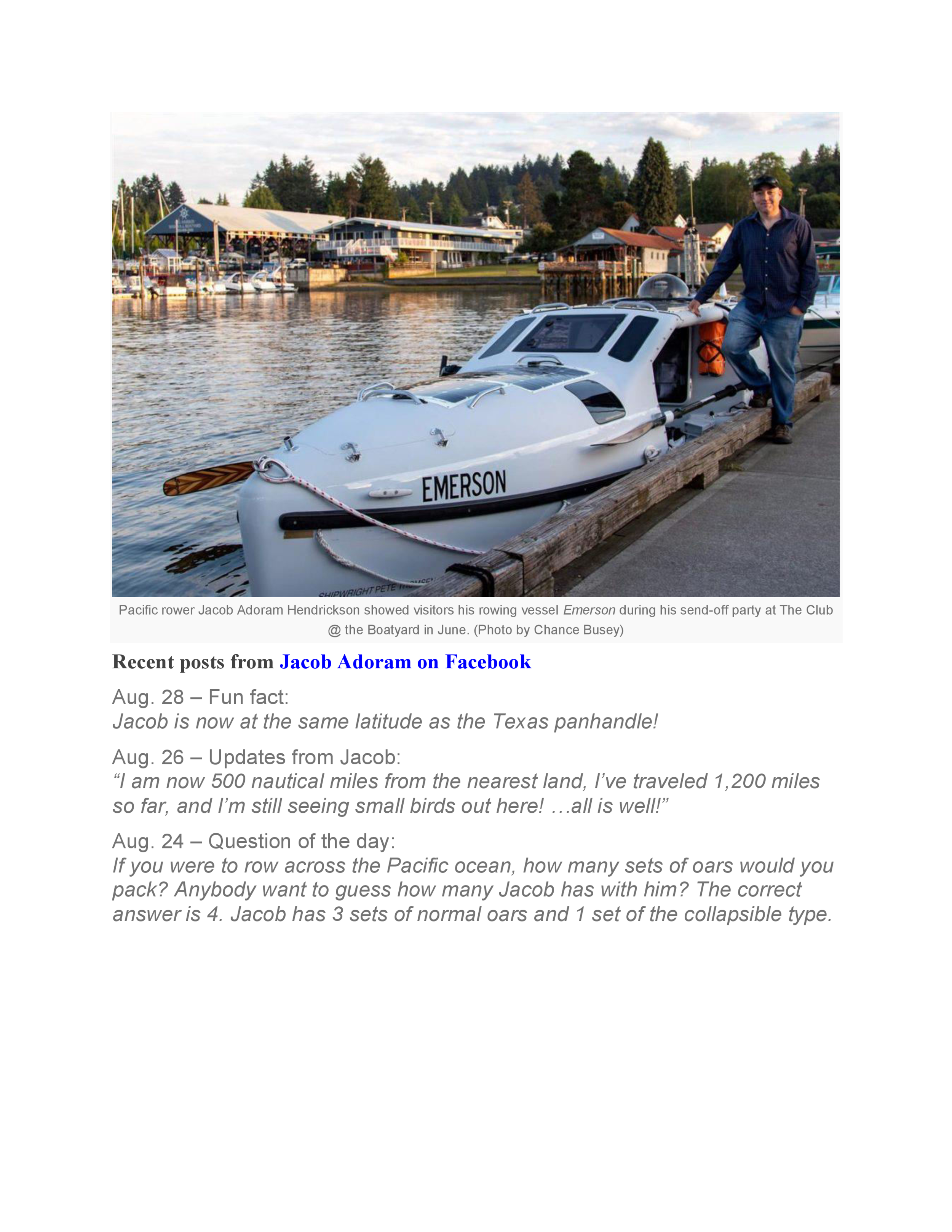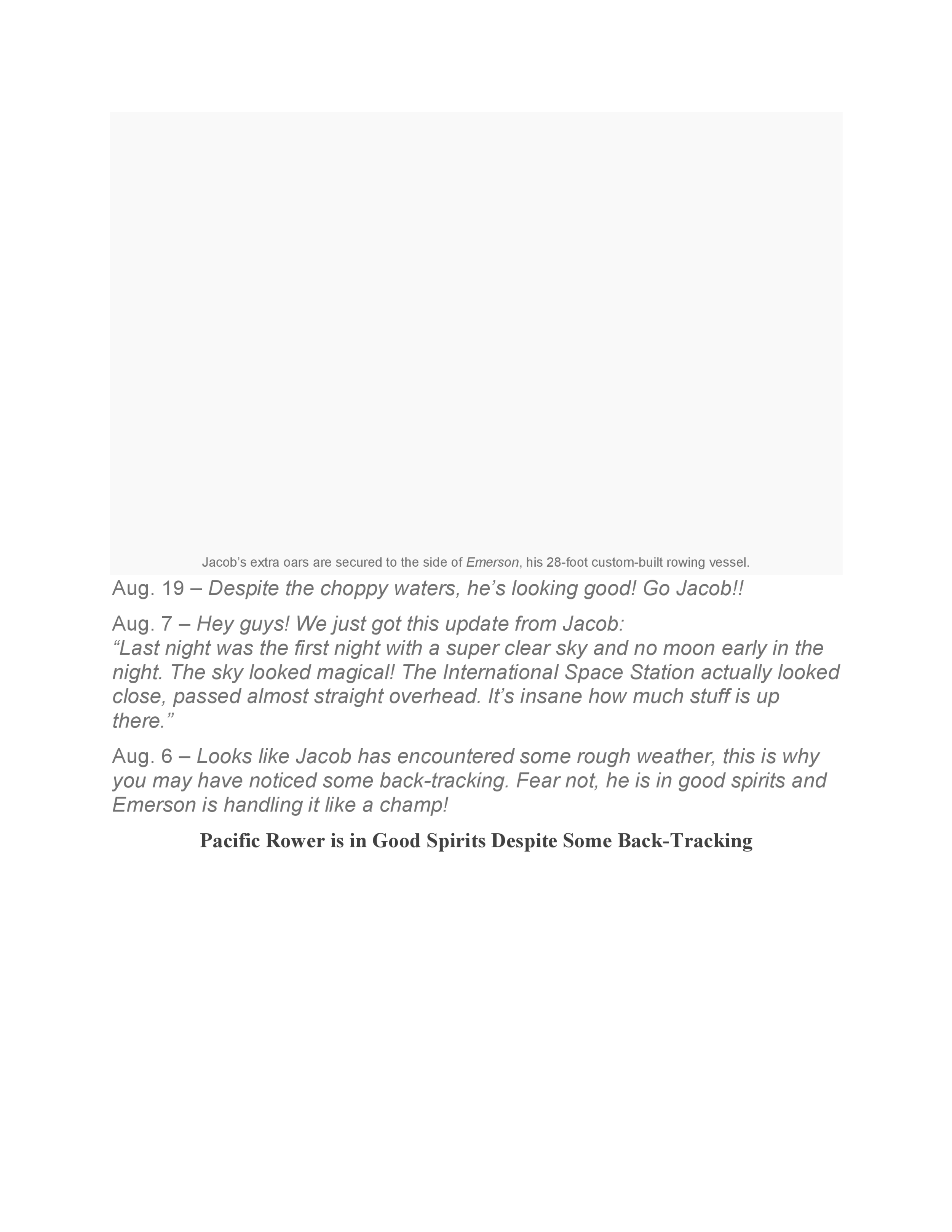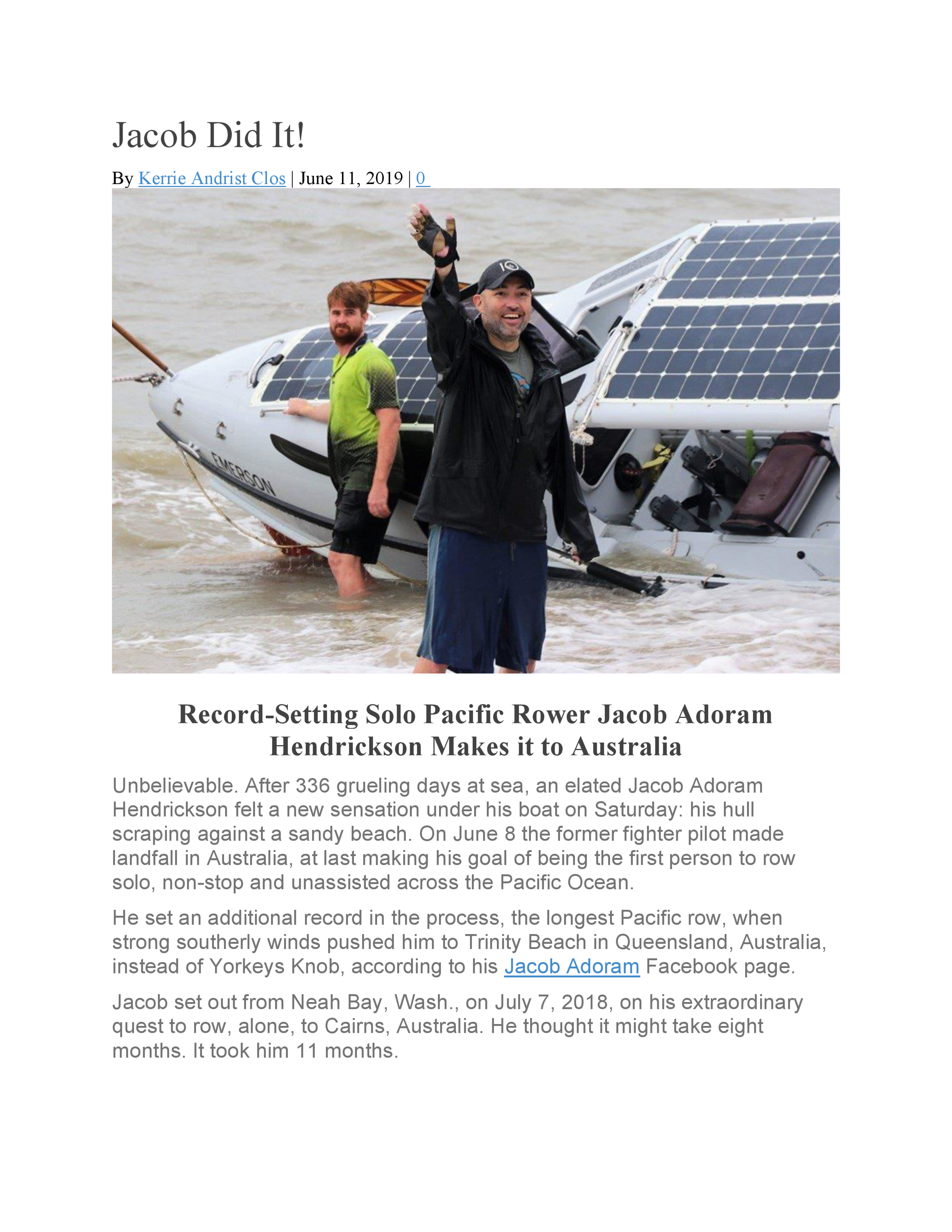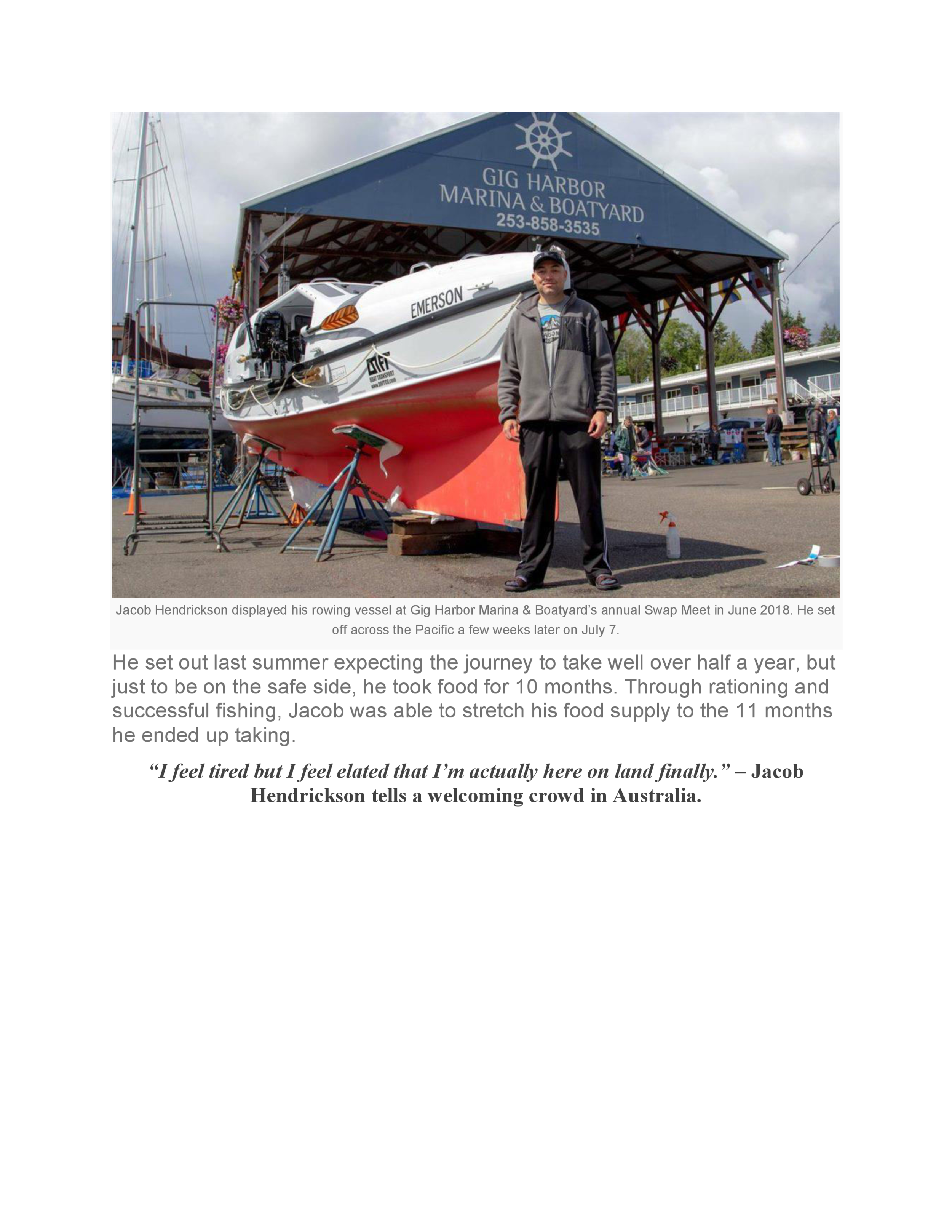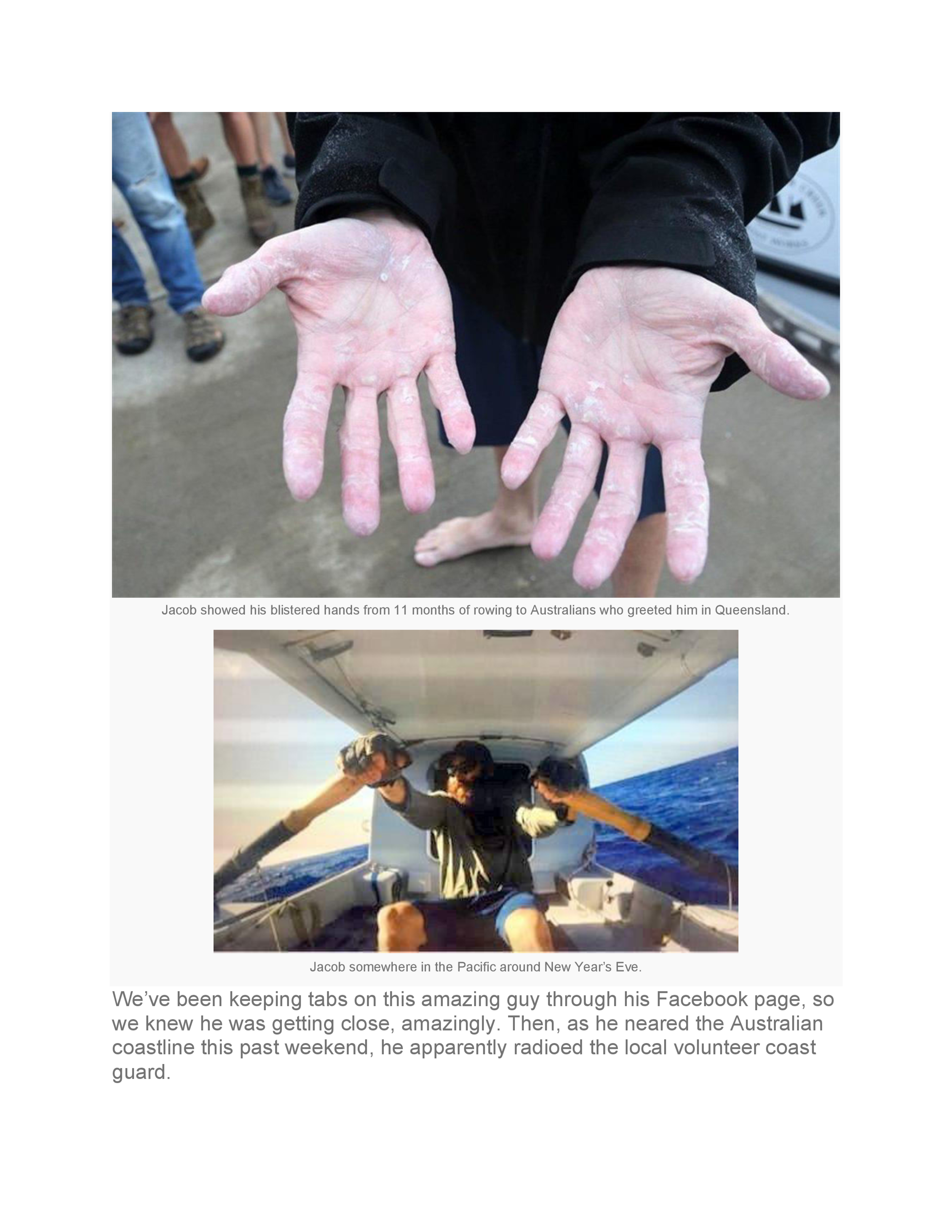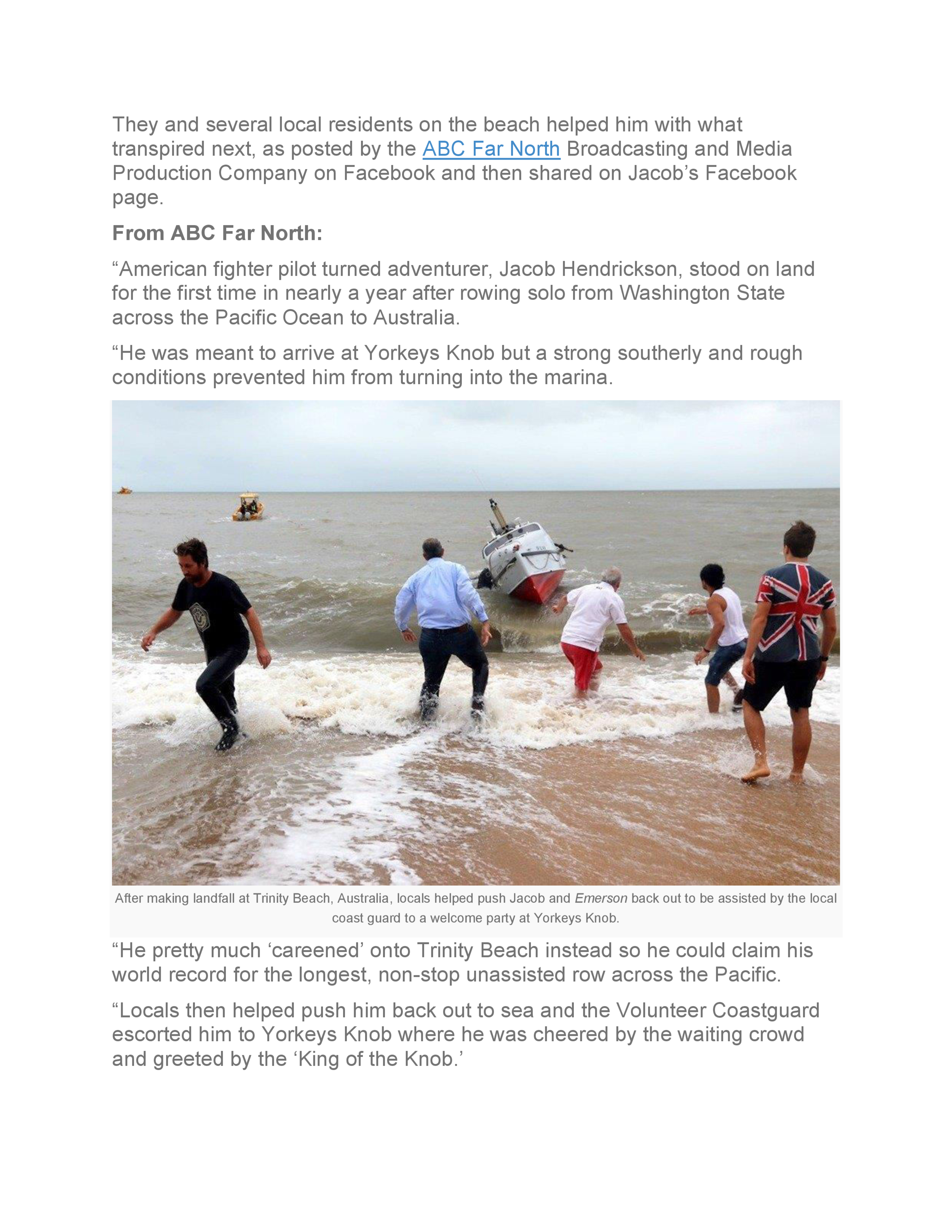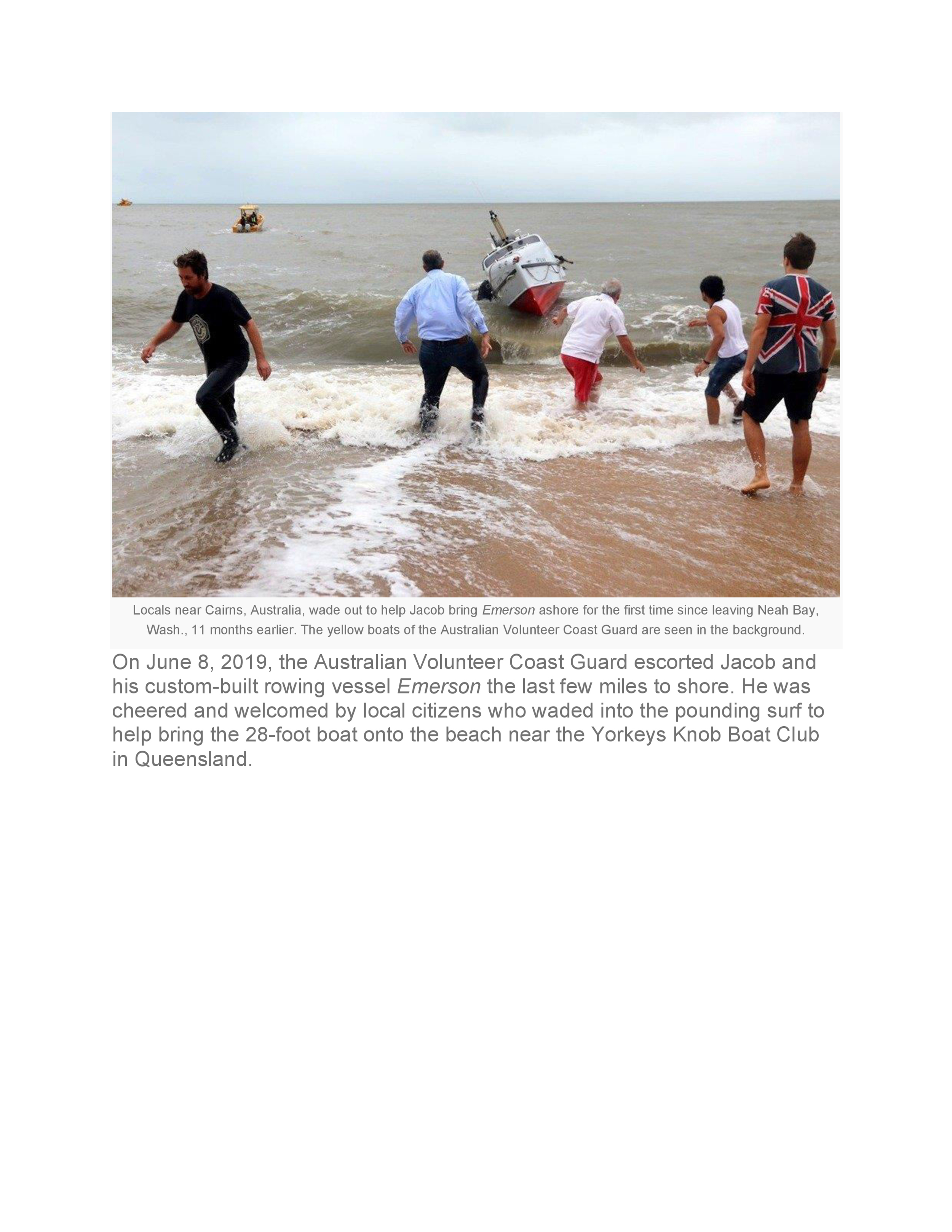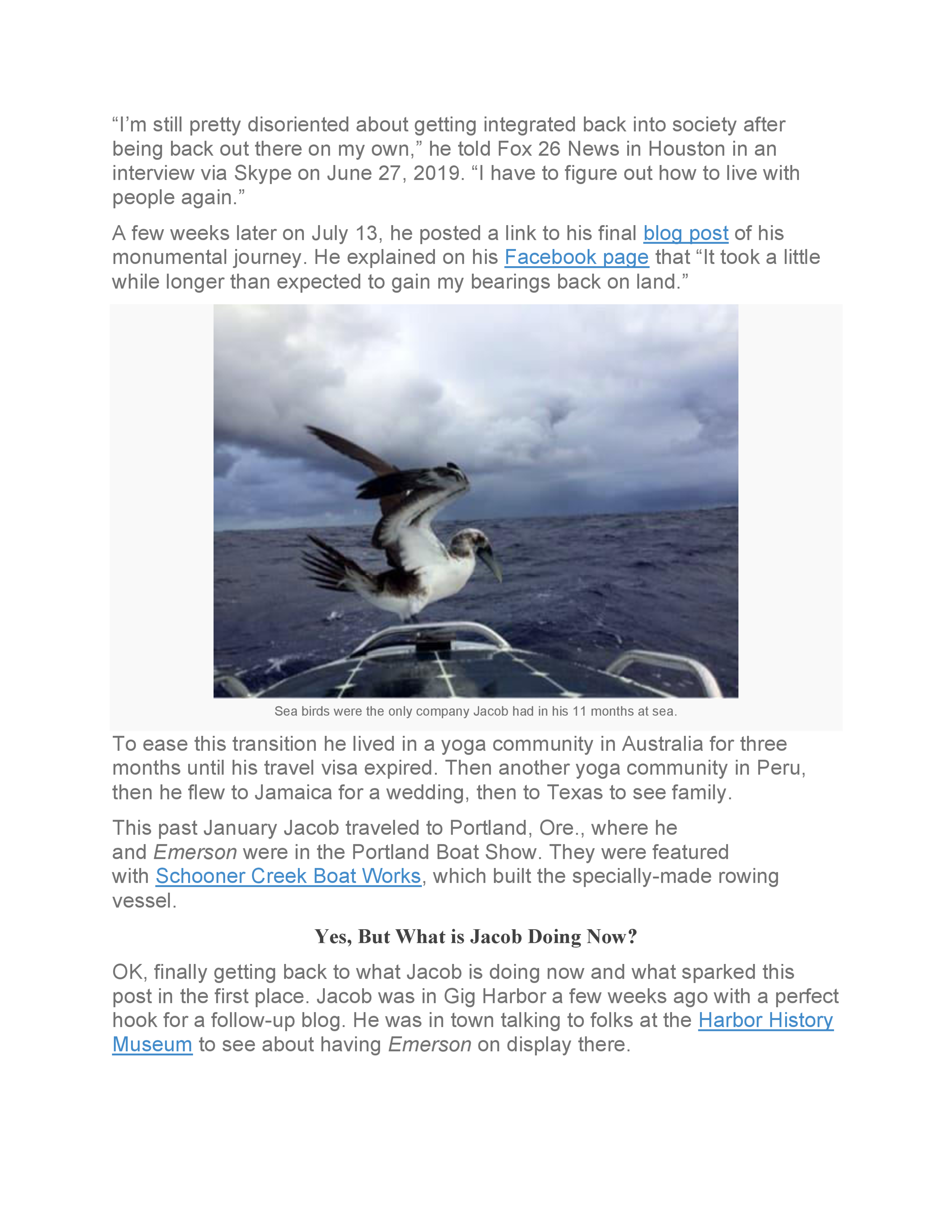The Press
Click any logo for the associated coverage! (Or just scroll down)
Harbor History Museum - Gig Harbor, WA
THe Mystery of the boat that was mistaken for a submarine
10 August 2020
By Sarah Czarnecki and S. Lile
Emerson and the Porpoise get situated in the museum courtyard as the Shenandoah looks on. Image courtesy of Jacob Hendrickson, 2020.
Just a week ago, under the near cover of darkness, a one-of-a-kind vessel arrived at the Harbor History Museum. It was placed in the Museum's courtyard for all to see. Yet, passers by wondered what the mysterious vessel could be. Was it a submarine? A marine life pod? A super secret spy boat? The truth is, Emerson, the boat in question, is none of those things. It is so much more. So much so, the boat is in the Guinness Book of World Records along with its owner and human engine Jacob Adoram Hendrickson.
What people find on closer inspection, is a high-performance rowboat used to cross the Pacific Ocean. But to get the full picture of what this boat is and all that its owner accomplished, we have to venture back across time and an ocean to 2013 when Jacob began to percolate an idea: What would taking on the challenge of rowing across the Pacific look like? Could a person make it across the Pacific, solo, non-stop, and unaided? What would it take to succeed?
Hungry for a challenge that would push him to his limit, Jacob committed himself to making the row, working tirelessly to raise funds, train his body, find a boat, and plan every single detail of his risky endeavor. Finally, in 2018, five years after the tiny seed of an idea had taken root, Jacob embarked on what would become his record-breaking row, carried across the sea by a boat called Emerson.
The journey began in July 2018 at Neah Bay, Washington, and ended with a stormy beach landing in June of 2019 at Cairns, Australia. After spending 336 days rowing across the Pacific Ocean, with only himself and the sea life to keep him company, he had earned his place in the Guinness Book of World Records for the longest solo, non-stop, unaided row across an ocean. With his entry in the record book, he de-throned Erden Eruc of Turkey, who previously held the title with his 312-day row back in 2008. Yet Jacob's journey was more about the rediscovery of heart, soul, and determination than breaking records.
The route across the Pacific. Although the statute miles were just over 7,000, Jacob actually rowed about 10,000 miles total due to weather and current setbacks. Map courtesy of Schooner Creek Boatworks and Jacob Hendrickson.
Jacob and Emerson have been back on land after their 336-day row for about a year now, with the vessel rousted from storage at the Schooner Creek boat shop in Portland where she was built. Jacob has graciously loaned her to us for the next few months, and in the true spirit of Quarantine Slapperdashery, we've created an outdoor exhibit that encourages COVID-safe viewing even though the main museum galleries remain closed. Even more safe, is reading this article. So, if you're curious about this mysterious boat, read on to discover her unique story. How was she constructed? What exactly makes her unique? How well did she serve her purpose of carrying Jacob across the Pacific? We know the outcome of her and Jacob’s story, but the mystery lies in all the steps it took to get there.
Who is Jacob Hendrickson?
Even before his record-breaking row, it was clear that Jacob wasn’t one to settle for being average. Originally from Houston, Texas, he was a pilot in the U.S. Air Force for 12 years, flying combat missions before eventually becoming a defense contractor. Anyone who knows about what it takes to become an Air Force pilot knows that this, in and of itself, is no small feat. In 2015, he pedaled across the country on a recumbent bicycle, all while his boat was being designed and built back in Portland. To pay for the construction of his boat, he flew all around the world, balancing his work with time spent in Portland with the boat team at Schooner Creek and preparing for his cross-country bike and eventual row. There is a certain tenaciousness one needs to break a world record of this caliber, and Jacob has proved he has just that.
The larger question in all of this, of course, is what compelled him to take on such a momentous task? To speak with him now about his voyage, he seems to reflect on it with a certain clarity one can only gain from hindsight. He told Speak Out Loud that, back in 2013 when he was still a pilot in the Air Force, he came to the realization that he “wasn’t living life properly,” but rather, “completing a series of tasks” to get through life. It seemed as though he simply felt lost and hoped that a challenge would help him find his way.
Designing for the Unknown
Emerson was designed by naval architect Eric Sponberg. She is 28-feet long and weighs 2,590 pounds minus the weight of the rower, food, and other supplies. She is a balancing act of length and weight; too long and heavy and she would be unwieldy, too short and she would not fit all the necessary equipment.
Emerson, named for Jacob's favorite dog, was custom designed by naval architect Eric Sponberg and built at Schooner Creek Boatworks in Portland, OR. There is a compartment for everything, including a water purifier and 1,000 pounds of food. Solar panels on the roof provided enough energy for all of Jacob's needs, from boiling water to running the navigation equipment, lights, and a laptop. Plans courtesy of Jacob Hendrickson.
In an article he wrote for Professional BoatBuilder Magazine, Sponberg states of his design framework, “you don’t want to be outside the norms unless you are trying to prove something unusual.” The irony of this statement is that, although “Emerson” was designed largely within the realms of conventional standards, the journey she was being built to undertake was, in a way, meant to prove something unusual. Her very existence falls outside the norm. Aside from the sheer length of the adventure, you can never know what the open ocean is going to throw your way. To design her, Sponberg and Hendrickson had to point blindly in the directions where they felt problems could arise and attempt to address them before the row began.
When one reads about the design and build process of Emerson, it feels almost as though Jacob outfitted her as one would dress a child going out in the snow. He took care in ensuring comfort as well as utility while at the same time making sure she was ready to face all elements of the journey ahead.
Everything had to be accounted for in her design; efficiency, storage, stability, ventilation, rowing position, and comfort were all weighed against one another. To add to the challenge, Jacob had certain requests about which he was adamant (a perk of having a custom-built boat is that you can make special requests). According to Sponberg, the ability to see the horizon over the aft cabin as well as the possibility of a 360-degree view were paramount for Jacob; necessities taken from his days as a pilot. He also wanted to be able to stand fully upright in certain areas.
If you look at the design image below, you will see that the visibility challenge was tackled with a 3-paneled window on the aft cabin as well as a globe-top window in which Jacob could position himself to gain a 360-degree view of his surroundings. The addition of foot wells provided the ability to stand upright.
Another special feature on the boat is a hardtop “roof” over the rowing station. This was added as a measure of protection against possible inclement weather. The hardtop afforded Jacob protection as well as extra space for placing solar panels that would charge the three deep-cycle marine batteries needed to power the navigation, steering and fresh-water equipment.
The Long Haul
“The first row is silent, as I've made customary. I get a sense for how the boat is responding to the environment. It's not entirely obvious or self-evident how the boat will respond. Seemingly identical conditions can produce wildly different results.” (From Jacob’s Blog. Nov 26, 2018)
To row thousands of miles unassisted is no small feat. It takes immense faith in oneself, physical ability, and mental fortitude to spend nearly a year alone doing nothing but the back and forth of rowing. Yet this was the entire point of the journey: Hendrickson was hungry for a challenge that would shake up the way he lived his life. The row, however, is just the tip of the iceberg. Although he officially embarked on his ocean row in July of 2018, he began preparing for it much earlier, systematically tackling problem after problem in the slow-going process of designing, training, and planning for his row.
As mentioned earlier, the idea came about in 2013. Jacob was able to get out to Portland in 2014 for the design and build process of Emerson. It was then two years before construction on her even began. During this time, Jacob was communicating back and forth with Sponberg and flying to raise money to fund the build and the rest of his expenses. Once the build began in 2016, it would be another two years before Emerson would get out on the water. Jacob mentions his frustration with the seemingly sluggish process of it all, saying that he “knew the preparations were going to be daunting, especially with a custom design and build, but it's been exhausting.” (June 15, 2017)
Yet, despite his frustration with the demoralizing pace of the preparation, Jacob stuck with it. He took navigation courses, got in touch with a dietitian for food-planning, and worked at slowly training himself physically and psychologically for the demands of his impending row.
If we take a step back from the 336 days spent rowing, we can see that Emerson, herself, was a challenge. A challenge to design, a challenge to fund, a challenge to move. She asked of Jacob perseverance years before he even embarked. In order to get her built, he needed to be dogged in his determination, for she was the first hurdle and the first step; without completing her, his mission was impossible. She taught him perseverance and patience from the very beginning, and he rose to the challenge to meet her so they could take on the Pacific together.
“In a way, it became my close friend...”
If you were alone for nearly a year, towards what would you turn for companionship? Jacob mentions looking to the ocean and sea life in moments of solitude. Equally, he mentions Emerson. “In a way, it became my close friend” he says of the boat, “It was the one thing I had that I paid very close attention to and I knew exactly what was going on with it.”
In one interview, Jacob says Emerson became almost like his “Wilson” – a reference to the Tom Hanks film, Castaway. She provided some sense of austere companionship in the absence of human contact.
Emerson was also a landing pad for visitors. From flying fish to blue-footed Boobys, the boat was a tiny island amidst the massive sea. Photo courtesy of Jacob Hendrickson.
Patience was not the only thing Emerson gave to Jacob. At one point near the end of his journey, Jacob rowed through Hurricane Anne, which soaked his sleeping cabin, lost him some food, and tossed he and much of his equipment about the boat. According to his blog post about the event, the winds and waves had Emerson rolling about 75-80 degrees. “I can't help but imagine if I were in a different, lighter rowboat, I would've tumbled over during that spell. Emerson is remarkably stable, and for that, I'm grateful." Sponberg’s meticulous design process endowed Emerson with the ability to provide stability to Jacob, not merely in terms of seafaring capacity, but also in the place he had chosen to call home for nearly a year. She was designed for stability on the open ocean, granting Jacob the peace of mind necessary to accomplish the task at the crux of his journey; re-evaluate his standing in life.
Emerson gave Jacob the space he needed to reflect on himself and his life trajectory. The boat was both transport and sanctuary through 15,000-foot-deep waters filled with creatures both curious and hungry. Without her, the much-needed space for unprecedented physical and mental challenge never would have been possible. According to Jacob, the trip afforded the opportunity, “to take a while to widen the aperture and try to look at yourself from a third-party view.” His time out on the open seas made him more aware of himself and of the world around him. “I never really set out to seek meaning in life and now that’s a whole new way of looking at the world and it’s obvious to me now why you would want to seek meaning, you know; because it’s the best way to connect with who we are as humans.”
Jacob reached Carins, Australia on June 8th, 2019, 336 days after setting out from Neah Bay, Washington. He and Emerson may no longer be alone with one another out on the Pacific, but it seems as though their time together has impacted him in myriad ways. He now mentions slowing down before making decisions to ask himself what would really make him feel fulfilled or satisfied. He talks about extending this mindful practice outwards towards his interactions with others; “Is everything I’m saying truthful and am I saying what I mean? If I’m not, how can I be clearer?”
Perhaps we can all learn from Jacob's journey; drawing on a shared determination to connect with our true selves and each other. After learning of Jacob and Emerson's journey, onlookers will forever see her as the symbol of bold determination.
We hope you’ll come by and take a peek at this magnificent vessel where she is exhibited with the Porpoise, another notable rowing vessel of a much different era. Until then, as Jacob would say at the close of his blog posts, "Paddle On."
View Jacob's Guinness World Record entry: https://guinnessworldrecords.com/world-records/619671-longest-time-rowed-non-stop-solo-across-an-ocean
Sources
https://www.thepursuitzone.com/tpz183/
The Ocean Rowing Society list of world-record, ocean rowing accomplishments: http://www.oceanrowing.com/guinness_world_records/list2006.htm
WNYC Think Out Loud
Rowing Across the Pacific
June 7, 2019
Jacob Hendrickson pushed off from the coast of Washington last July in a boat made especially for him by a boat builder in Portland. He spent the next 10 months rowing across the Pacific Ocean. He’s now anchored 30 miles off the coast of Australia, waiting for the weather to allow him to complete what will be the longest solo rowing voyage from North America across the Pacific.
Gig Harbor Living Local Magazine
Gig Harbor in Focus (Page 40) Text Only Version Below Images
Text Only Version Below
Air Force pilot will flex his water wings on an eight-month journey across the Pacific
By Dan Aznoff | Photo Courtesy of Jacob Hendrickson | Article provided by Gig Harbor Living
The challenge for a maritime resident of the Gig Harbor Marina will be how to explain to himself why in the world he chose to row his custom-made row boat across the 9,150 nautical miles from Neah Bay in Northwest Washington to Perth in Western Australia.
Air Force veteran Jacob Hendrickson knows a thing or two about adventure. He has first-hand experience with G-forces over the past 10 years flying combat missions over Afghanistan. He has pushed his reconnaissance jets to speeds that would make most sailors dizzy.
Then, during the long hot summer of 2014, he had an epiphany.
“Being an Air Force pilot had turned into just a job,” Hendrickson said with a straight face. “Flying combat missions can sometimes be difficult. But I was surprised when it actually became a bore.”
To cope with the tediousness routine of his dull life, the former Air Force Academy cadet challenged himself with the idea of propelling himself—alone—across the unpredictable ocean tides and treacherous currents between the West Coast of North America and the Land Down Under.
Weather permitting, he plans to begin his trek in early July but quickly added that he will delay his departure until he gets the eight to 10 days of good weather he’ll need to set a pace and his course for Australia.
His challenge, said Hendrickson, will test his ability to maintain his sanity that allows him “to understand the true definition of the term ‘grit.’”
The estimated eight-month crossing will force the jet jockey to “to experience patience and look inward at myself.”
The time alone with himself will not be a new experience.
“I currently live alone aboard a boat in the Gig Harbor Marina,” he said. “I live an isolated life. There will be no wife or kids anxiously waiting for me to walk ashore if, and when, I arrive in Perth.”
Being a realist, the affirmed bachelor knows that his amateur skills at sea-going navigation could mean that he may be end up thousands of miles from his intended destination.
“Odds are that I very well may end up in Hawaii or California,” he said. “Wherever my journey ends, it will be a valuable learning experience for my life.”
Hendrickson said his experience as an aviator has provided him with a working knowledge of navigation, but the currents and the winds at sea level present a different range of challenges than at 30,000 feet.
“The currents can act like the wind, but that’s where the similarities end,” he explained. “For a journey of this length, I had to make considerations as to the types of freeze-dried foods I could take along, how much toothpaste to pack, how much butane I will need to boil water, what type of music to bring and when I might need to deploy the sea anchor.”
He is still undecided on which audio tapes and how much music to bring along to occupy the long days without companionship. He may end up buying an electronic reader so he can have enough reading material, but that is low on his priority list right now.
Hendrickson played football at the Air Force Academy and performed with the band in high school. He has made the decision to leave his saxophone behind.
“I still need to decide whether or not I need to wear socks,” he said with a smile. “That’s a question Captain Cook and the early explorers never had to worry about.”
The ambitious sailor said his maritime dietary plan was devised as a class project by graduate students in sports medicine at Oregon State University. He will have a specially made water maker onboard to purify seawater for drinking and cooking.
The majority of the meals, he said, will be pre-packed with macronutrients to provide nutrition and cut down on the payload needed for the crossing.
Although the native of Austin, Texas, left the actual construction of his row boat to Schooner Boatworks in Portland, Hendrickson spent as much time as could spare at the factory to oversee the production. The concept for the ocean-going rowboat was the last boat designed by Eric Sponberg before his retirement. Hendrickson’s boat was featured in an article on the famed designer in a recent issue of Boat Builder magazine.
Sponberg was so proud of the craft he designed for the Air Force pilot, he included it on his personal website, EricWSponberg.com.
“My final boat design was an ocean-going rowboat for rowing solo, non-stop, across the Pacific Ocean. You can read about the history and development of my boat and mast designs on my new website.”
For his safety, Hendrickson will wear a four-point harness that will hopefully prevent him from being tossed overboard in rough seas. His 28-foot boat will weigh only 22 pounds before it will be stocked with provisions for the voyage.
The would-be captain was on hand to be part of the testing of the boat while under construction. The innovative design of the craft allowed it to right itself even if it was toppled over by high waves.
“I sat in the boat with the four-point harness when the boat was flipped during a test run,” he recalled. “My head was under water for only a few moments before the boat righted itself and I was vertical again.”
The safety precautions went beyond the design of the craft. Hendrickson said the row boat will be equipped with the latest in electronics to guard him against any unforeseen situations. He described the high-tech safety measures his own risk management plan.
The plan includes a satellite connection that will allow his volunteer support team to track the daily progress of the small craft as it crosses more than a dozen time zones. He will also carry a personal emergency beacon that can connect to a satellite system operated by the Federal Communications Commission.
So that he is never too far from modern conveniences, Hendrickson will also have unlimited access to texting friends and supporters around the world and access to a global rescue plane, if needed.
If the electronics fail, Hendrickson also plans to bring along a sextant, a compass and his watch, “Just in case.”
Finances were the largest obstacle to the journey for Hendrickson to overcome. His said his normal duties as a civilian contractor to the Armed Force commits him to two days on and two days off. His typical week over the past two years has been four days on and only one day off in order to build up the $800,000 in savings he estimates the adventure will ultimately cost.
The isolation, he said, will be a dramatic contrast to his normally hectic lifestyle.
“This was not an overnight decision,” Hendrickson concluded. “I jumped into this challenge with two feet into water that was over my head. No pun intended.”
The aviator predicted that his first order of business once he reaches dry land will be to eat a meal “that has not been pre-packaged or freeze-dried.”
Dan Aznoff is a freelance writer based in Mukilteo dedicated to capturing the cherished memories of our lifetime so that they may be passed to future generations. He was a finalist for the Pulitzer Prize for his coverage of the toxic waste crisis. Aznoff can be contacted directly at da@dajournalist.com.
KVAL 13 News Eugene Oregon
Record-setting solo Pacific Ocean journey in Portland-built boat nears its end
KOIN 6 News Portland, OR
Washington to Australia: Rower completes Pacific trek
Interview with Emily Burris of KOIN 6 Portland
KGMI News
Man completes record row from Washington to Australia
NEAH BAY, Wash. — A former Air Force pilot is on dry land in Australia this morning after setting a record for a solo row across the Pacific Ocean.
Jacob Adoram began his trek at Neah Bay eleven months ago and completed the longest ever, non-stop, unsupported solo ocean row this month.
“It was rowing, sleeping, and eating, and that’s about it,” he says of the journey.
He tells KOIN-TV via Skype that he was amazed by the weather on the open ocean, recounting one particularly intense moment.
“I probably got a 15-20 foot wave that broke directly on to my boat and rolled me 90 degrees . . . it ripped the oars off the side of my boat, cracked the oars, [and] water rushed everywhere,” he says.
Adoram spent years designing and building the 28-foot boat that he rowed more than 7,000 miles across the world largest ocean.
A documentary of his feat is being produced, the trailer of which can be seen below.
The Pursuit Zone Podcast
Episode 183
He is an Eagle Scout, a former military aviator, and an avid traveler who has explored over 35 countries. He rode a recumbent bicycle across the US using the Race Across America route and in July 2018 began rowing from Neah Bay, Washington to Australia, making landfall 11 months later at Trinity Beach, Queensland – a journey of over 7,000 statute miles in a custom-made rowboat and the longest solo, non-stop row from North America in the history of modern ocean rowing. He is also raising funds for Water Mission – a non-profit that builds and implements safe water, sanitation, and hygiene solutions for people in developing countries and disaster areas. You can learn more about him at his website jacobadoram.com. Jacob Adoram, welcome to The Pursuit Zone.
Triple M News Radio Melbourne
A Texan rower who spent 330 days at sea is expected to reach Yorkey's Knob today. What a legend.
June 7th, 2019
American Jacob Hendrickson has smashed a world record.
He's spent the last year rowing from Washington State all the way to Cairns in an attempt to complete the first ever solo, non-stop ocean row across the Pacific Ocean.
The coast guard confirmed poor weather meant Jacob hadn't made it to us as quickly as he would have liked but at 3am this morning he was awaiting customs clearance.
He's set to be celebrating with his family today!
Note: Unfortunately, I’m unable to locate the Australian television or radio coverage online. If someone can help - please email me at jacob@jacobadoram.com. Very much appreciated !
ABC Far North
SOLO ROWER ARRIVES AT TRINITY BEACH AFTER 336 DAYS AT SEA
June 8th, 2019
American fighter pilot turned adventurer, Jacob Hendrickson, stood on land for the first time in nearly a year after rowing solo from Washington State across the Pacific Ocean to Australia.
He was meant to arrive at Yorkeys Knob but a strong southerly and rough conditions prevented him from turning into the marina.
He pretty much "careened" onto Trinity Beach instead so he could claim his world record for the longest, non-stop unassisted row across the Pacific.
Locals then helped push him back out to sea and the Volunteer Coastguard escorted him to Yorkeys Knob where he was cheered by the waiting crowd and greeted by the 'King of the Knob'.
Mr Hendrickson's hands were covered in blisters and he struggled to remain steady on his sea legs.
"I feel amazing. I feel tired but I feel elated that I'm actually here on land finally. It feels so weird on stable ground once again," he said.
He said the journey was aimed at raising awareness and funds to help developing countries access clean water, and also figuring out how he wanted to live his life.
"I would say that it was like I was in a weird time vortex that was filled with all kinds of different animals and sea creatures and self reflection and allowed for me to learn more about myself, learn more about the world and help me set a new direction in my life for the future."
Mr Hendrickson said he was looking forward to a hot meal and beers after nearly a year of mainly freeze-dried meals.
What a journey! Congratulations!




Gig Harbor Marina & Boatyard Blog
Meet Jacob Adoram Hendrickson
Follow Jacob’s Solo Pacific Row
Pacific Rower Still Under Way
Jacob Did It!
LEt’s Take a Pause: What is Jacob Doing Now?
I’d like to extend a special thanks to Gig Harbor Marina & Boatyard for the support throughout this journey! I’d also like to thank you for taking the time to organize a special evening before I left, helping me raise money for Water Mission.
